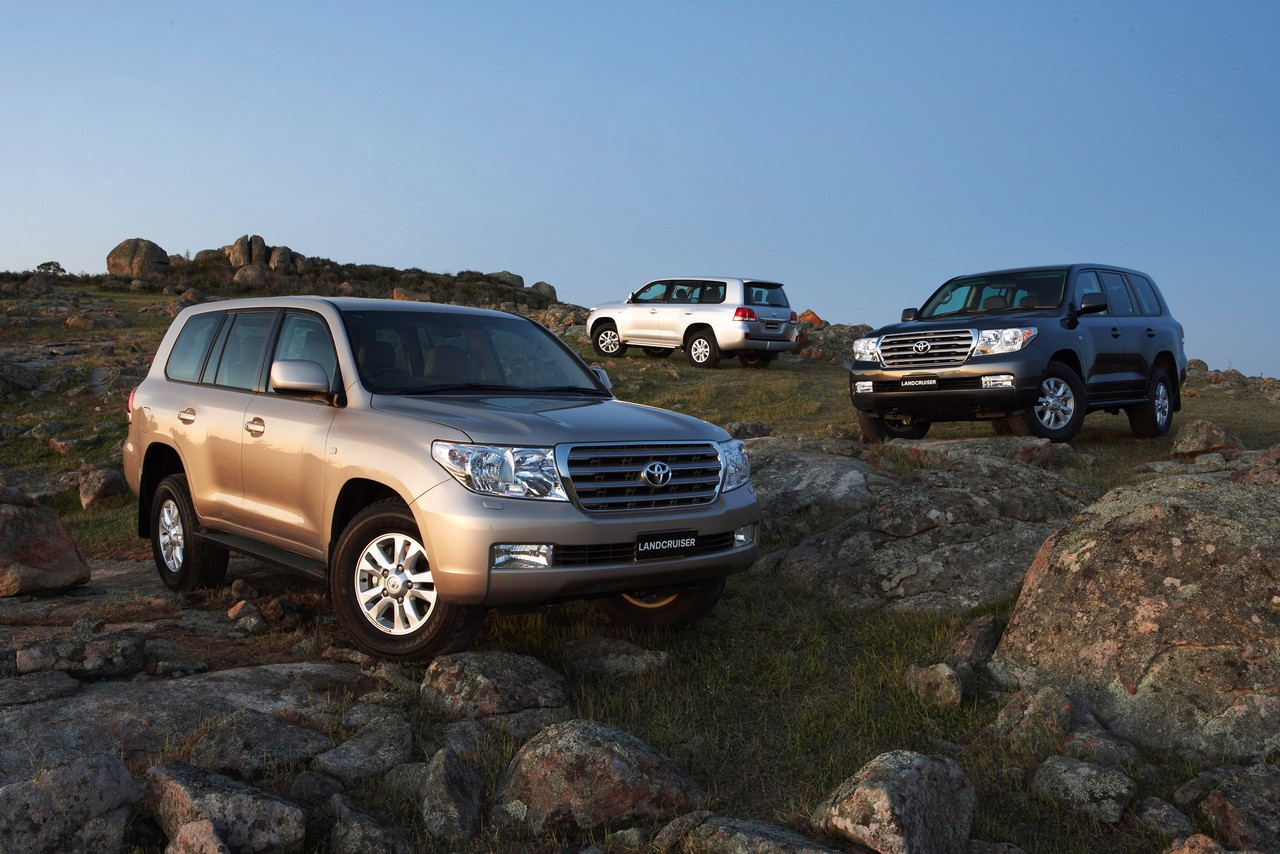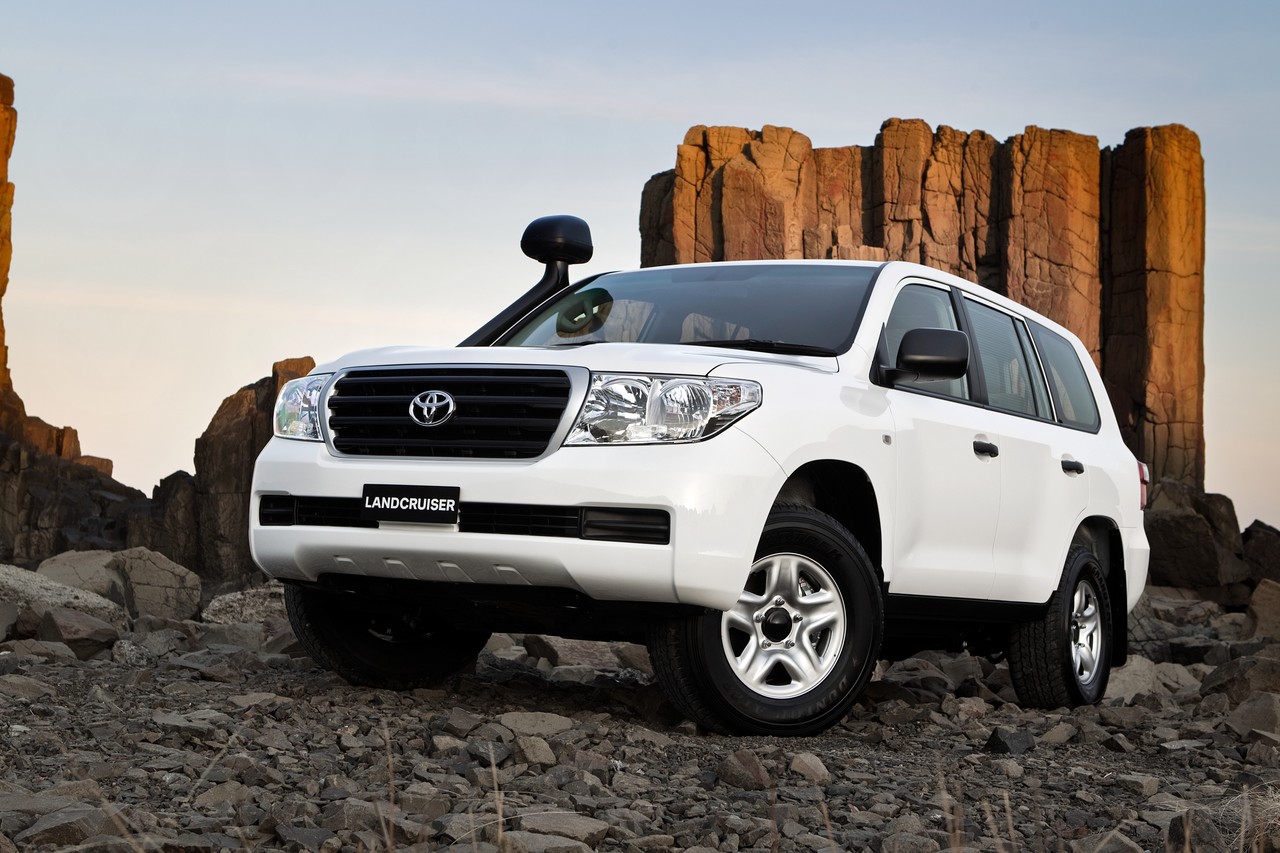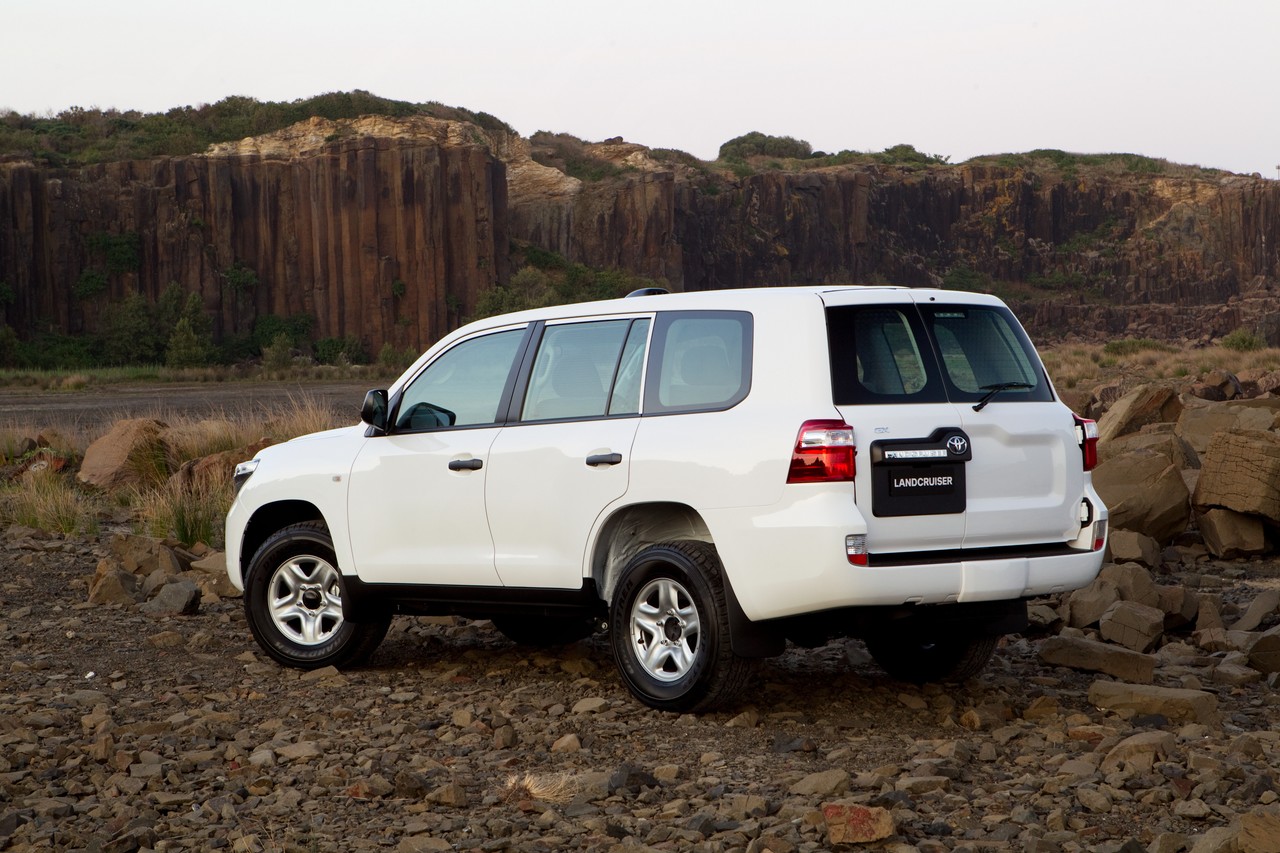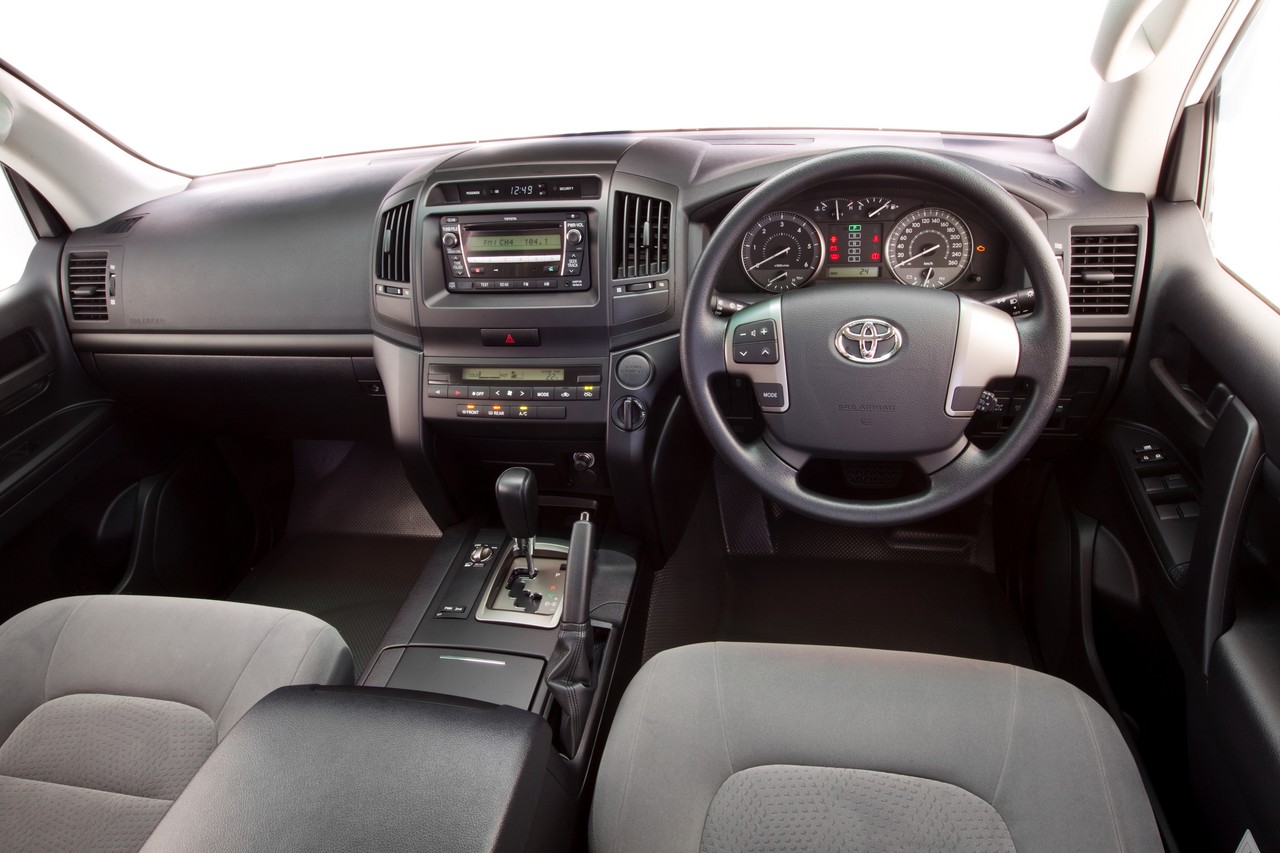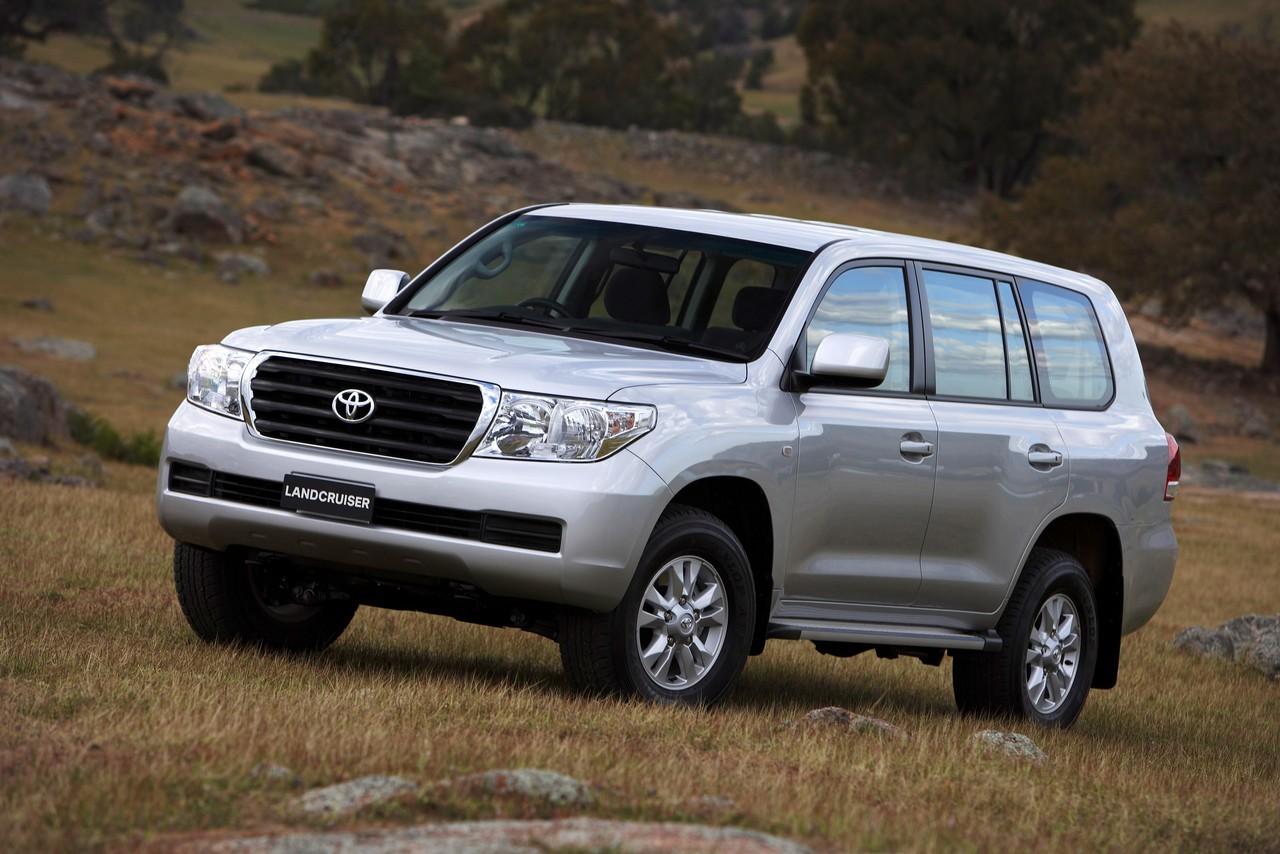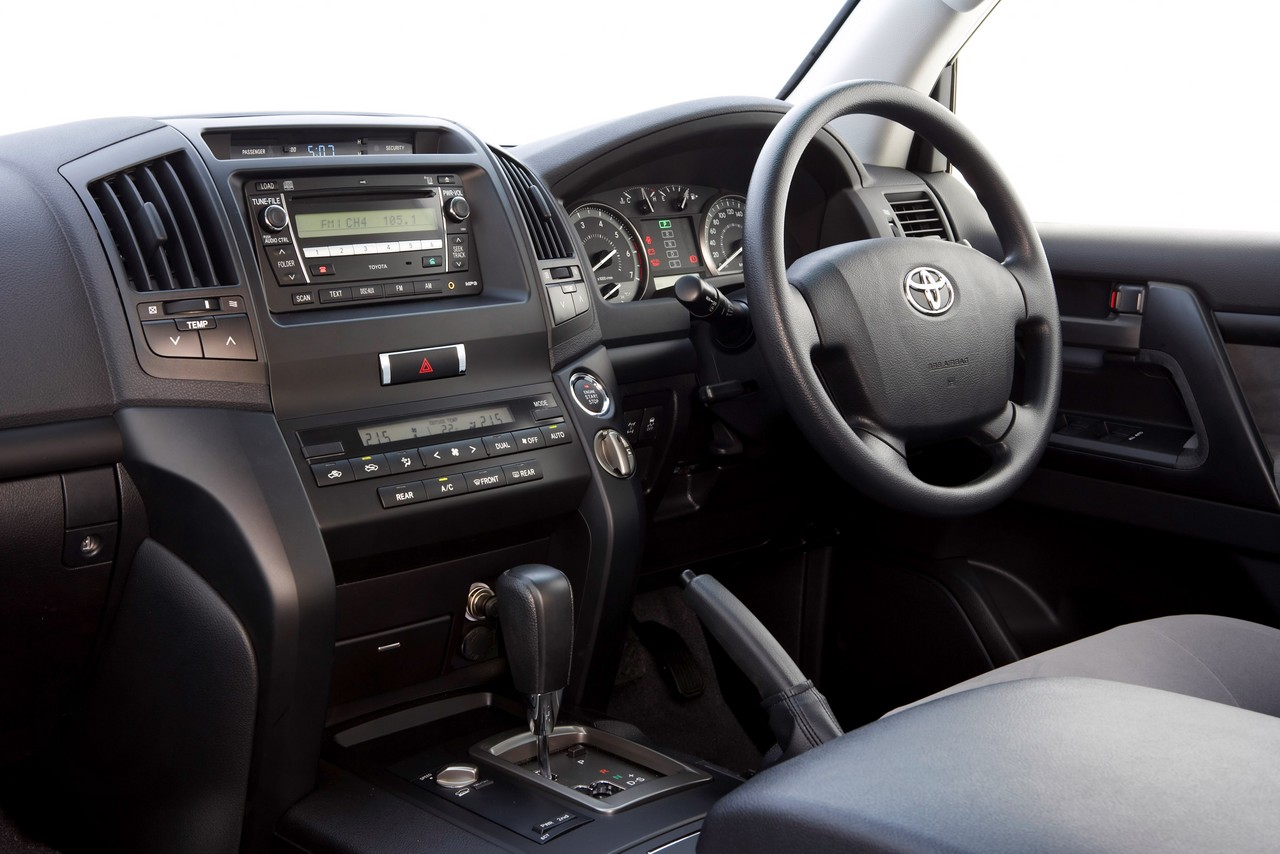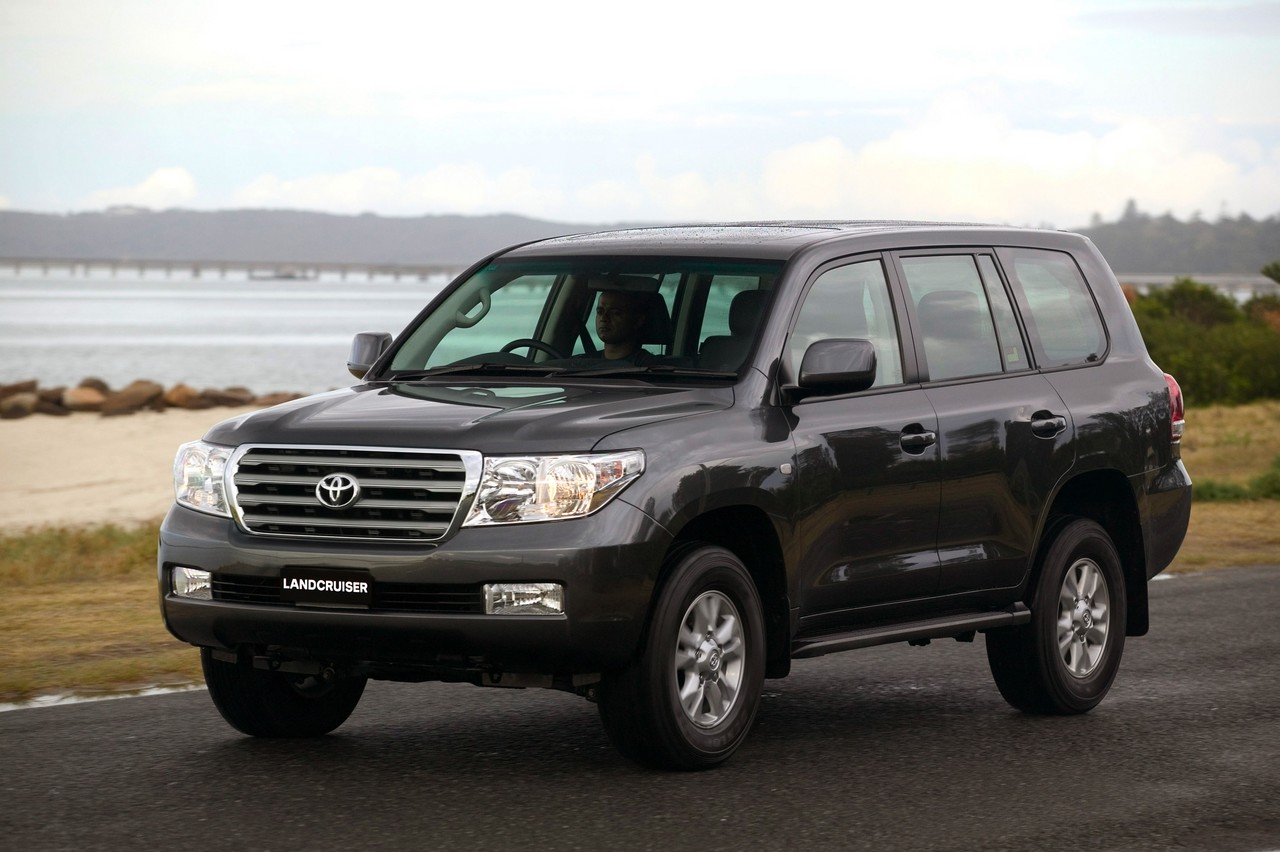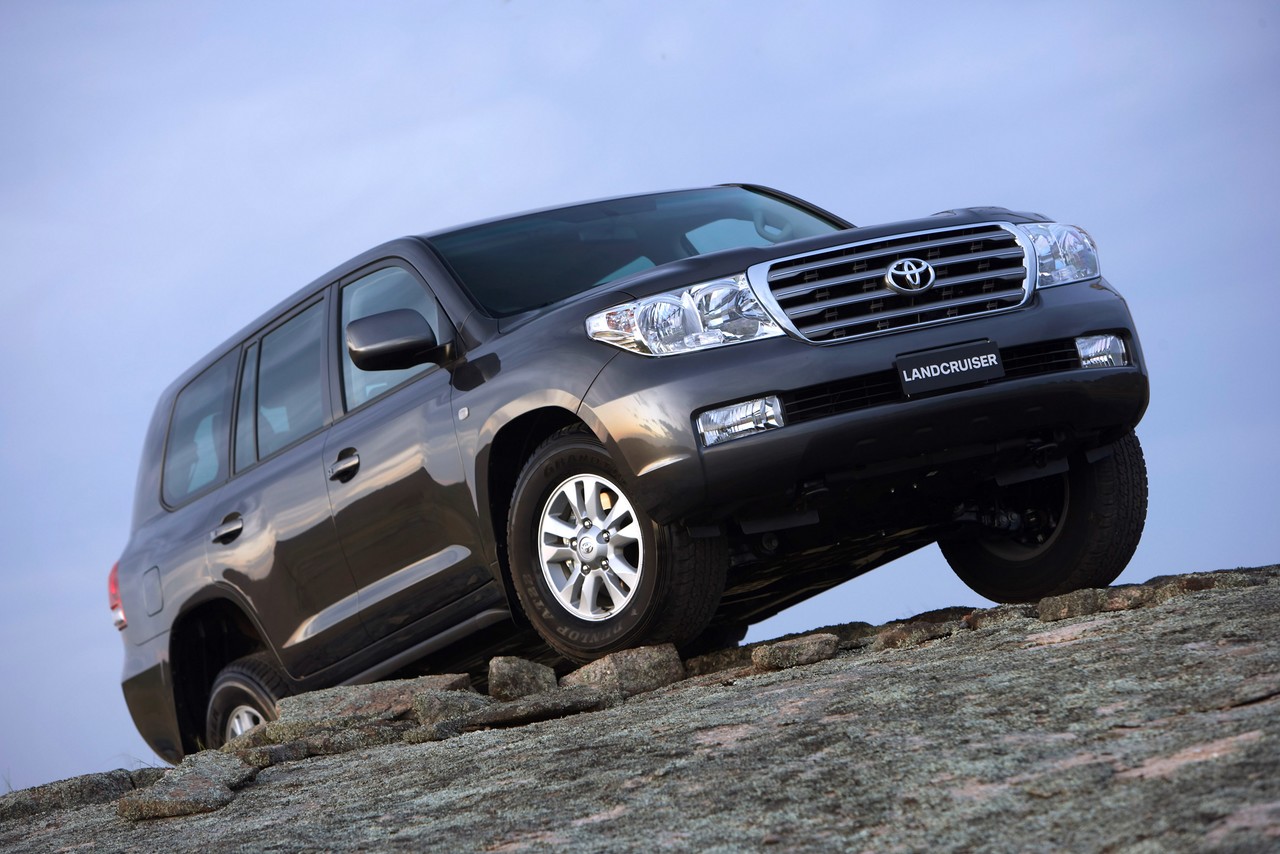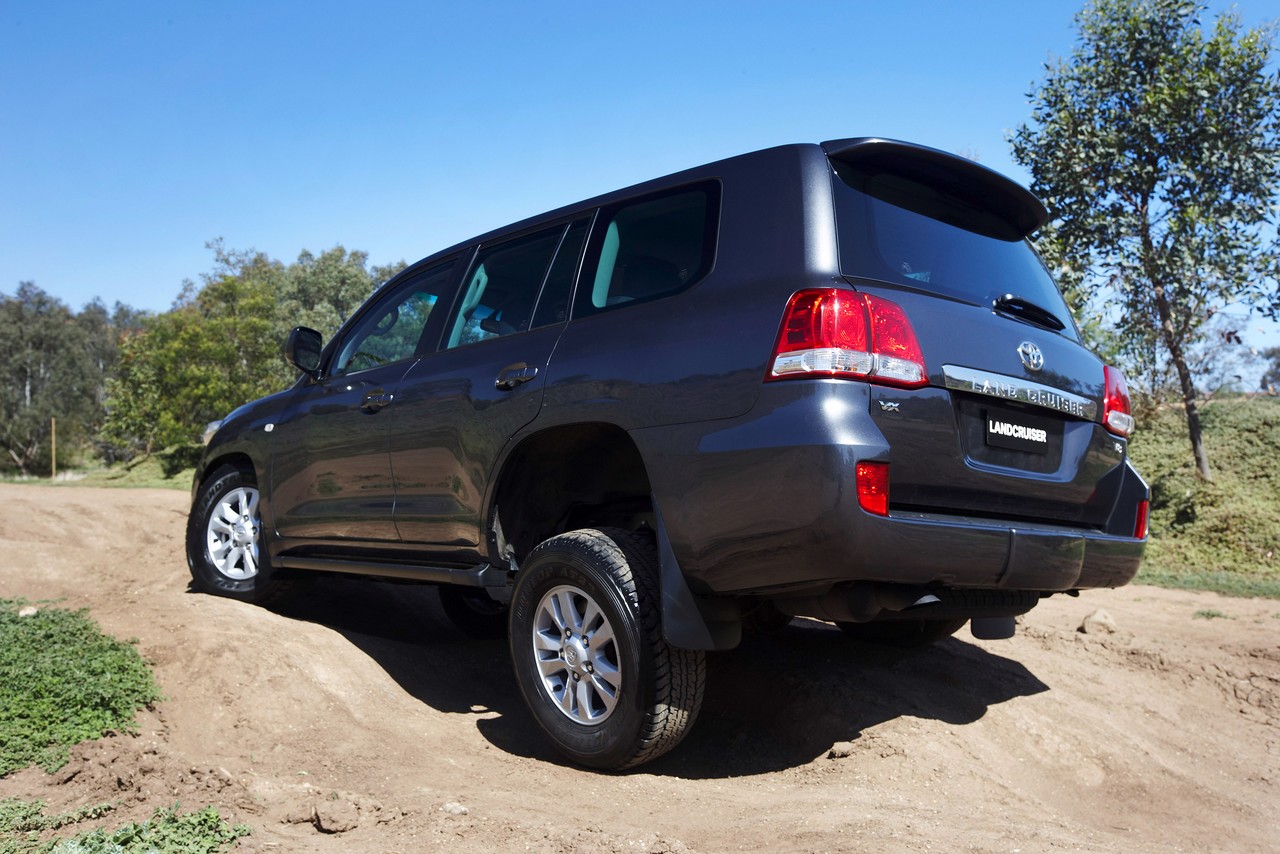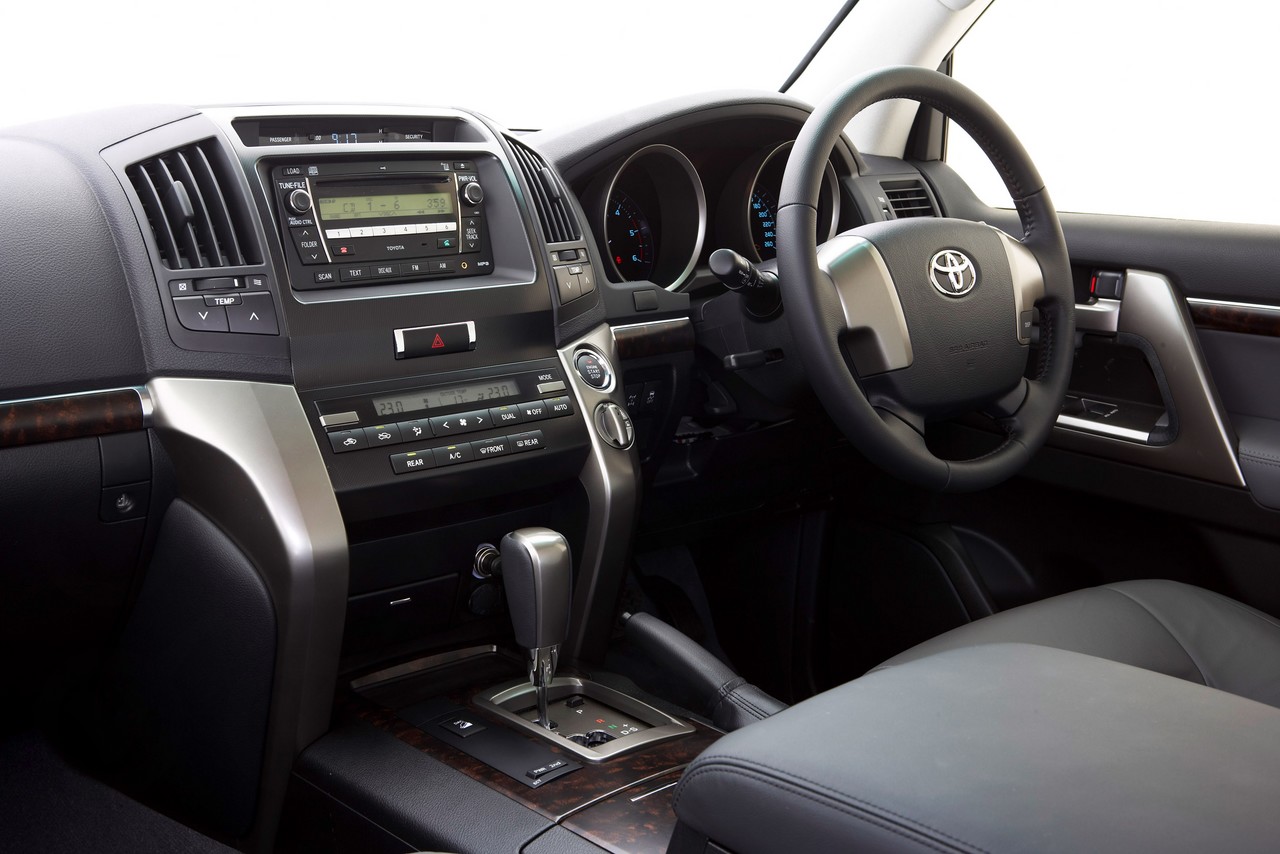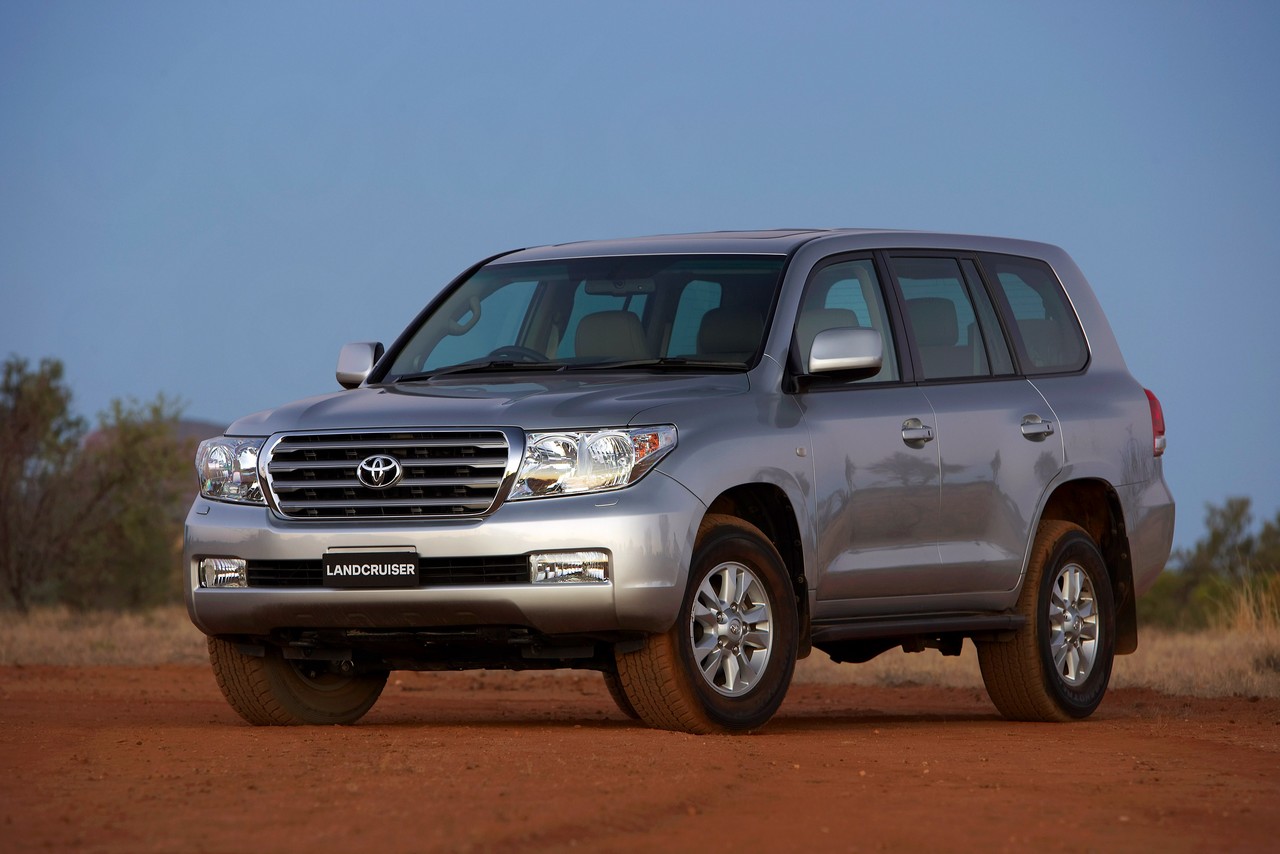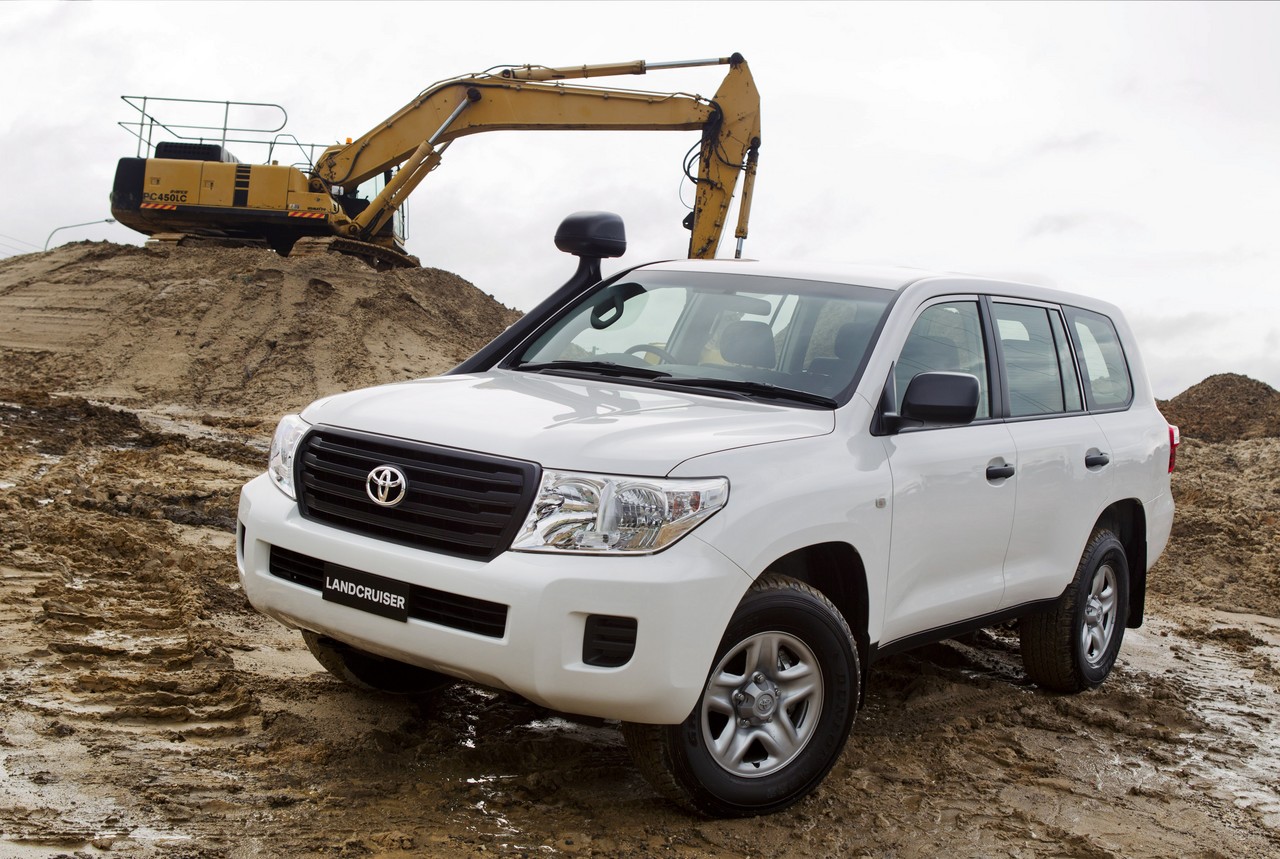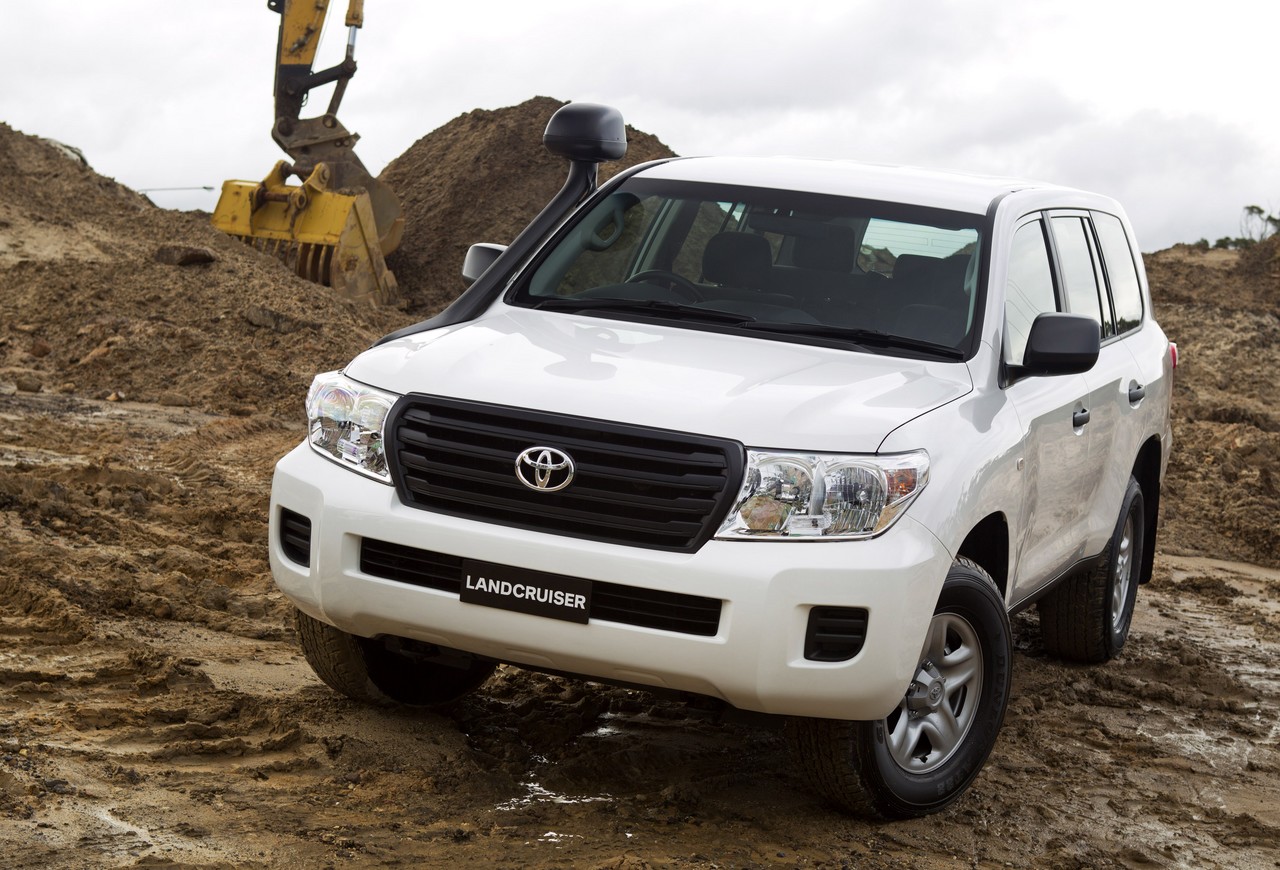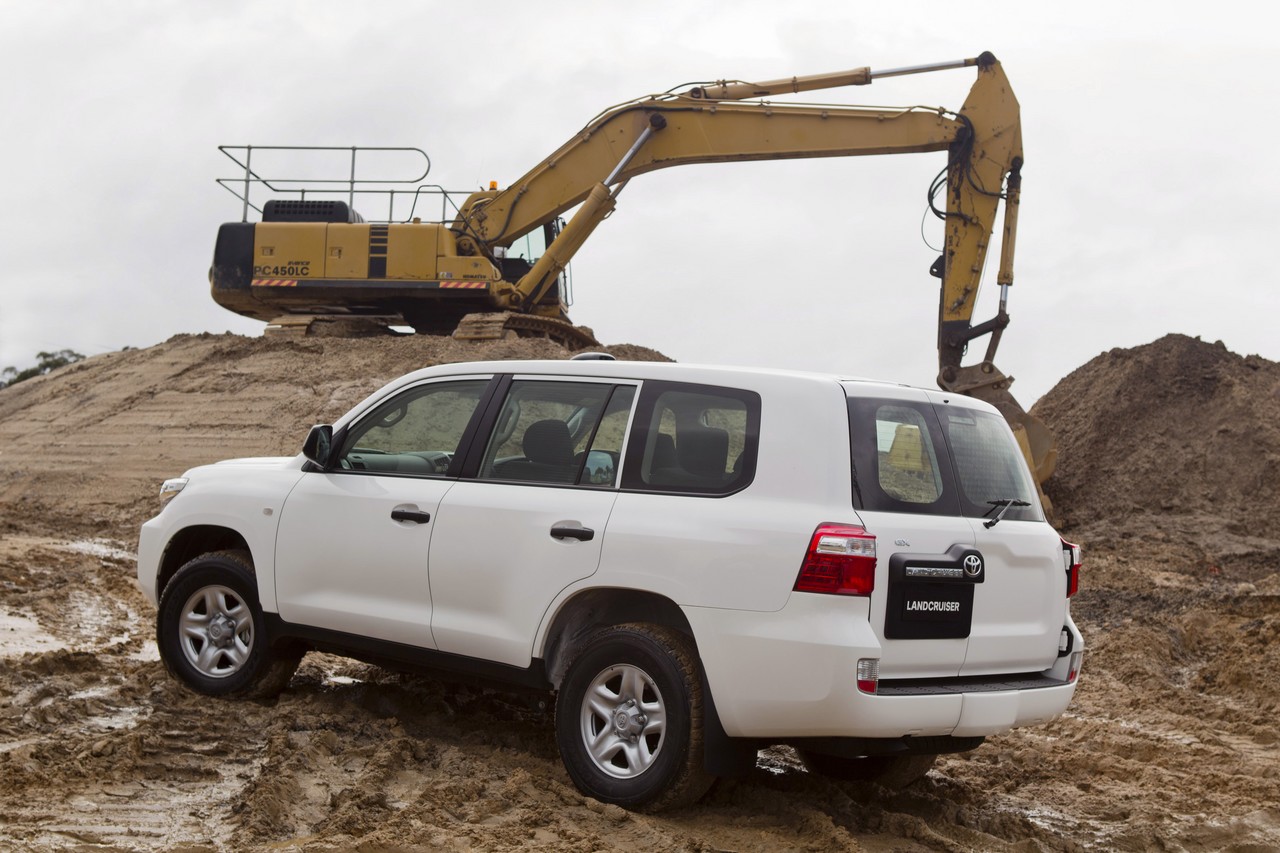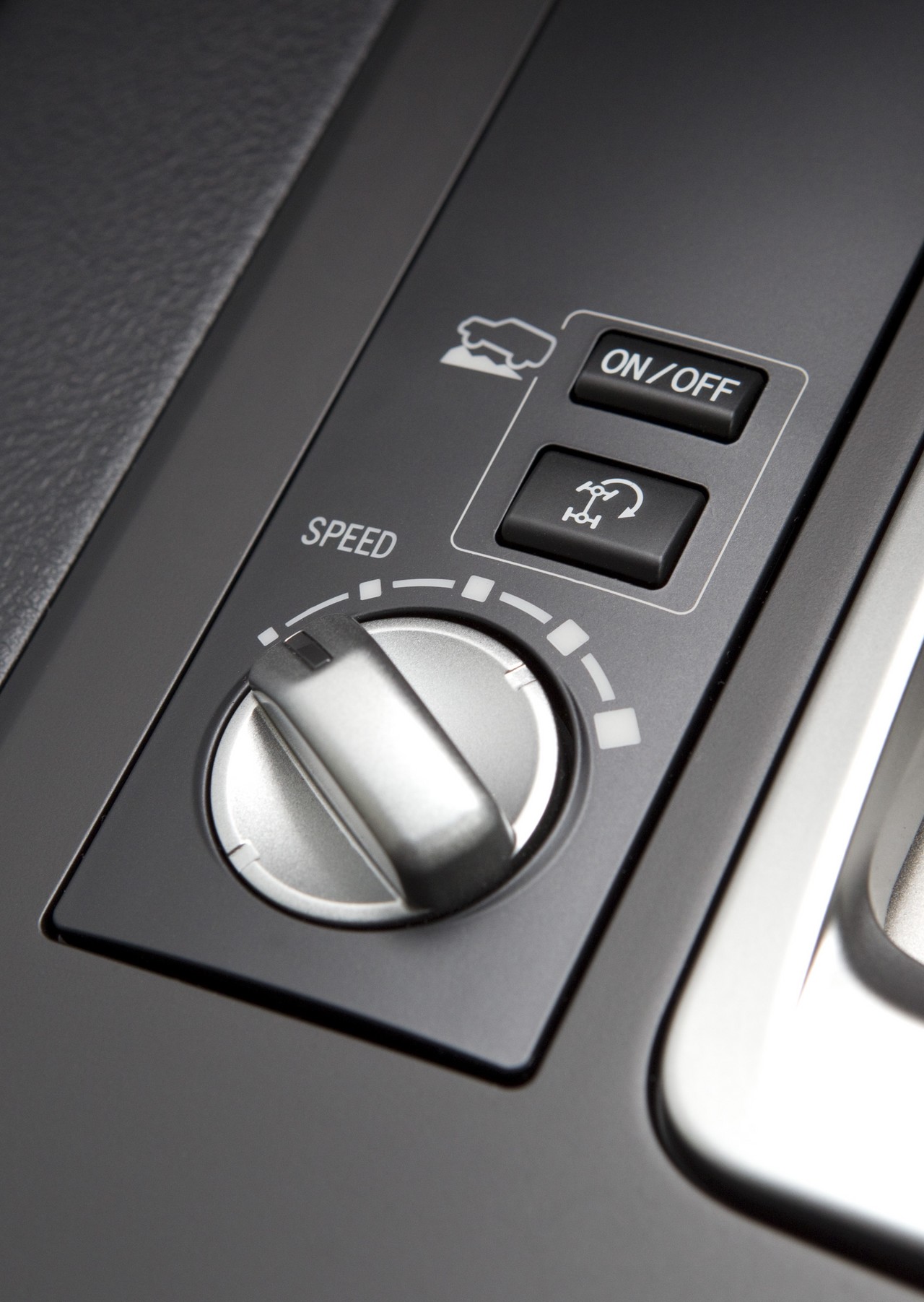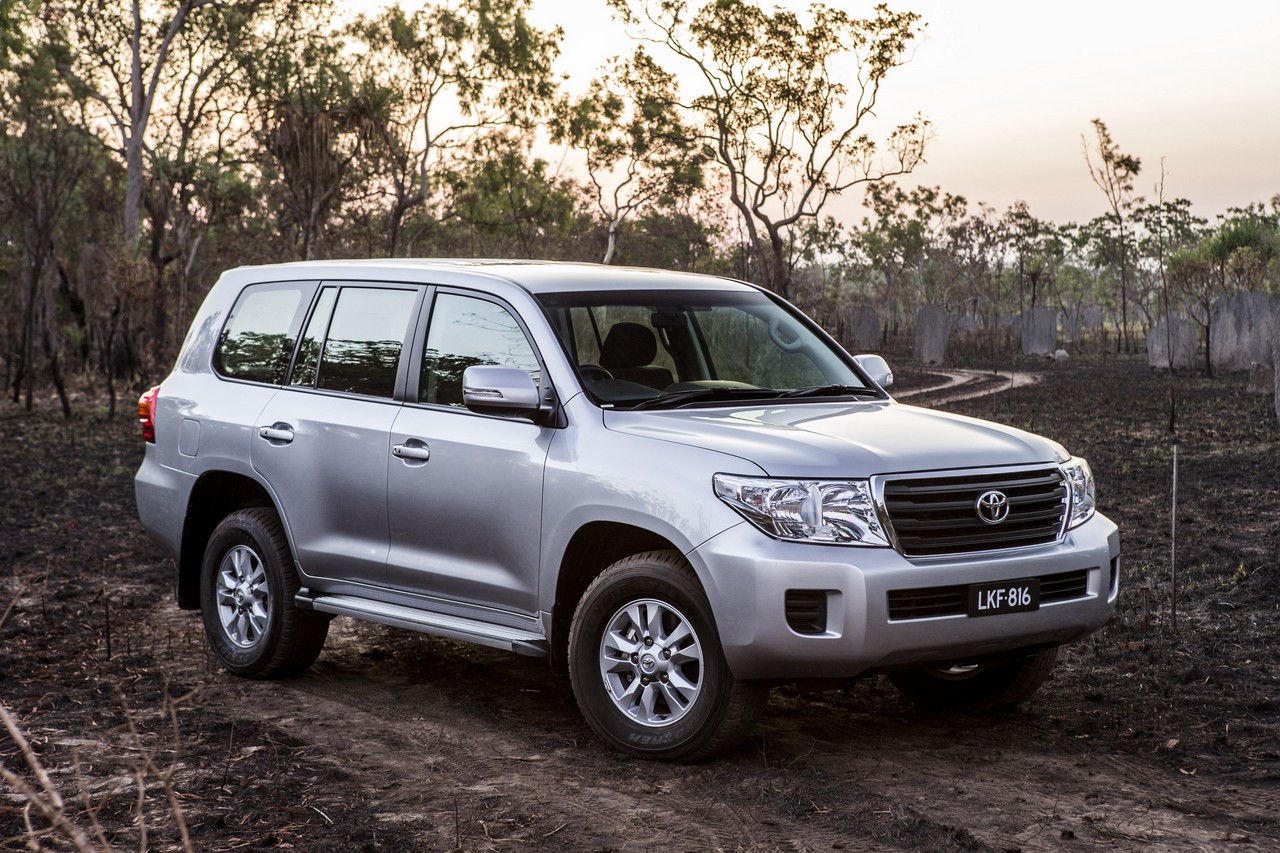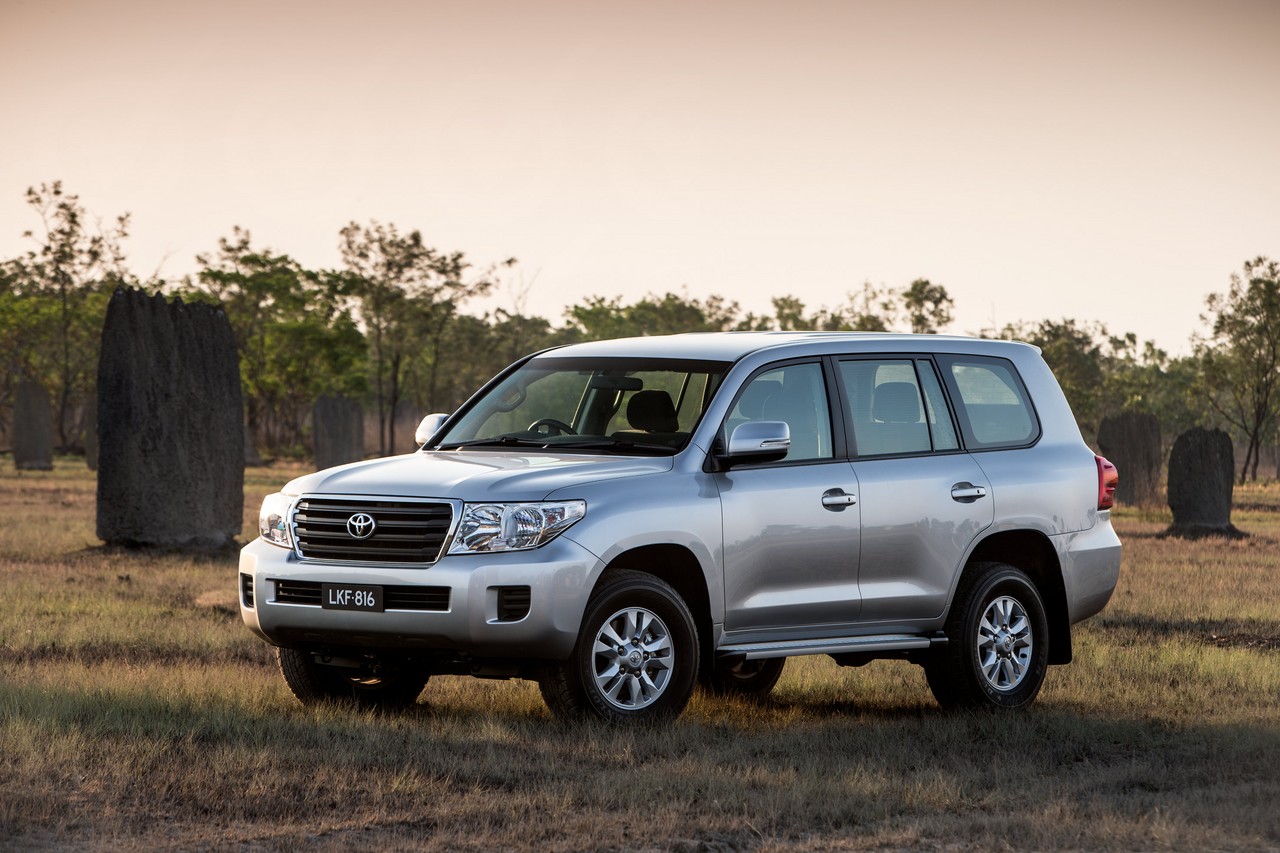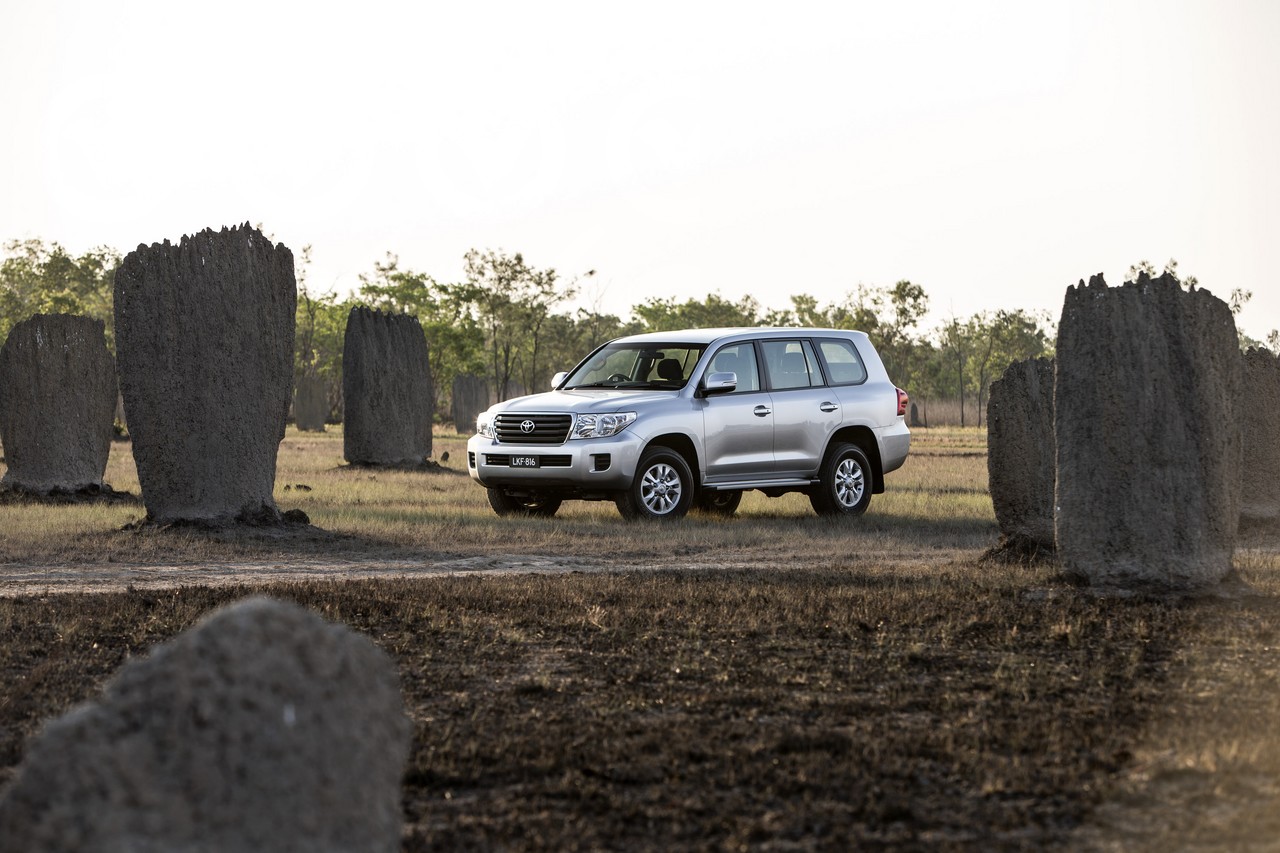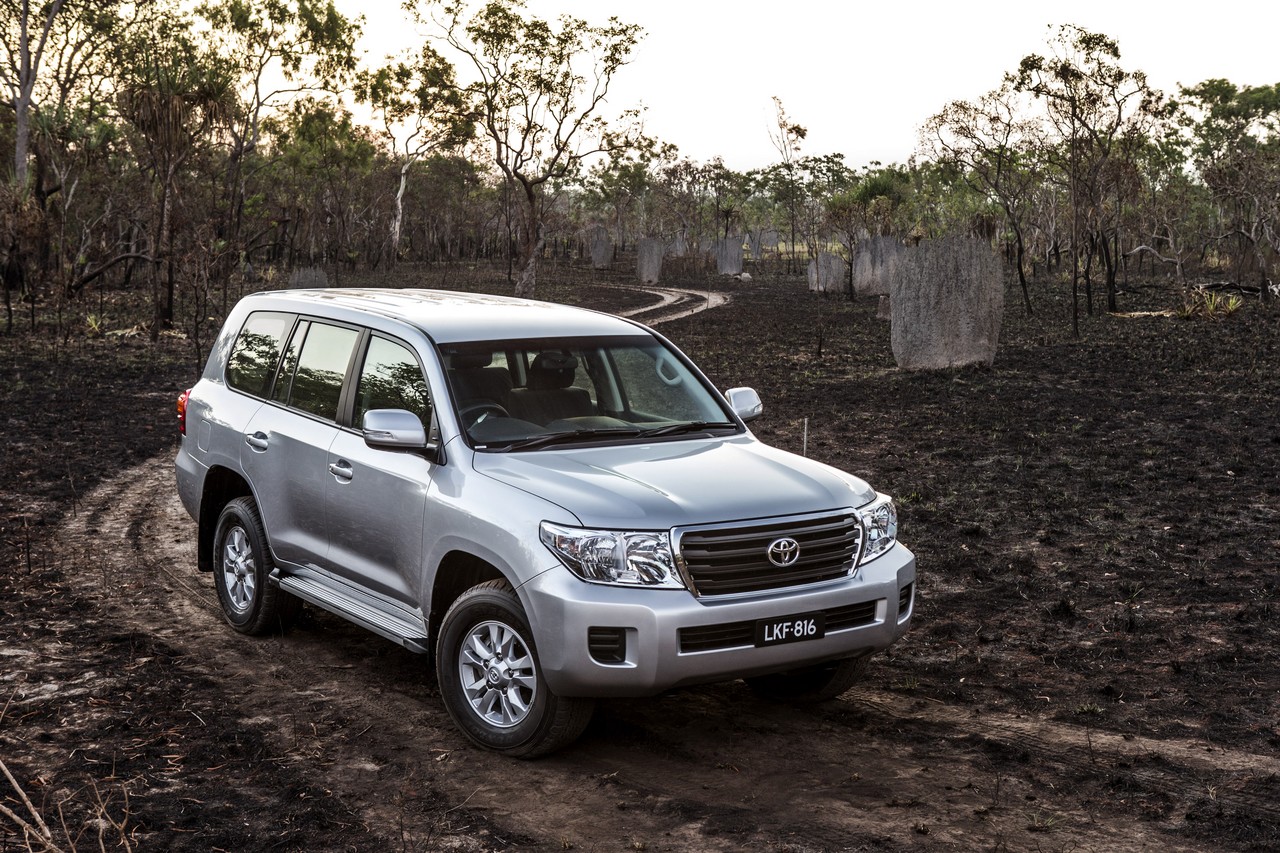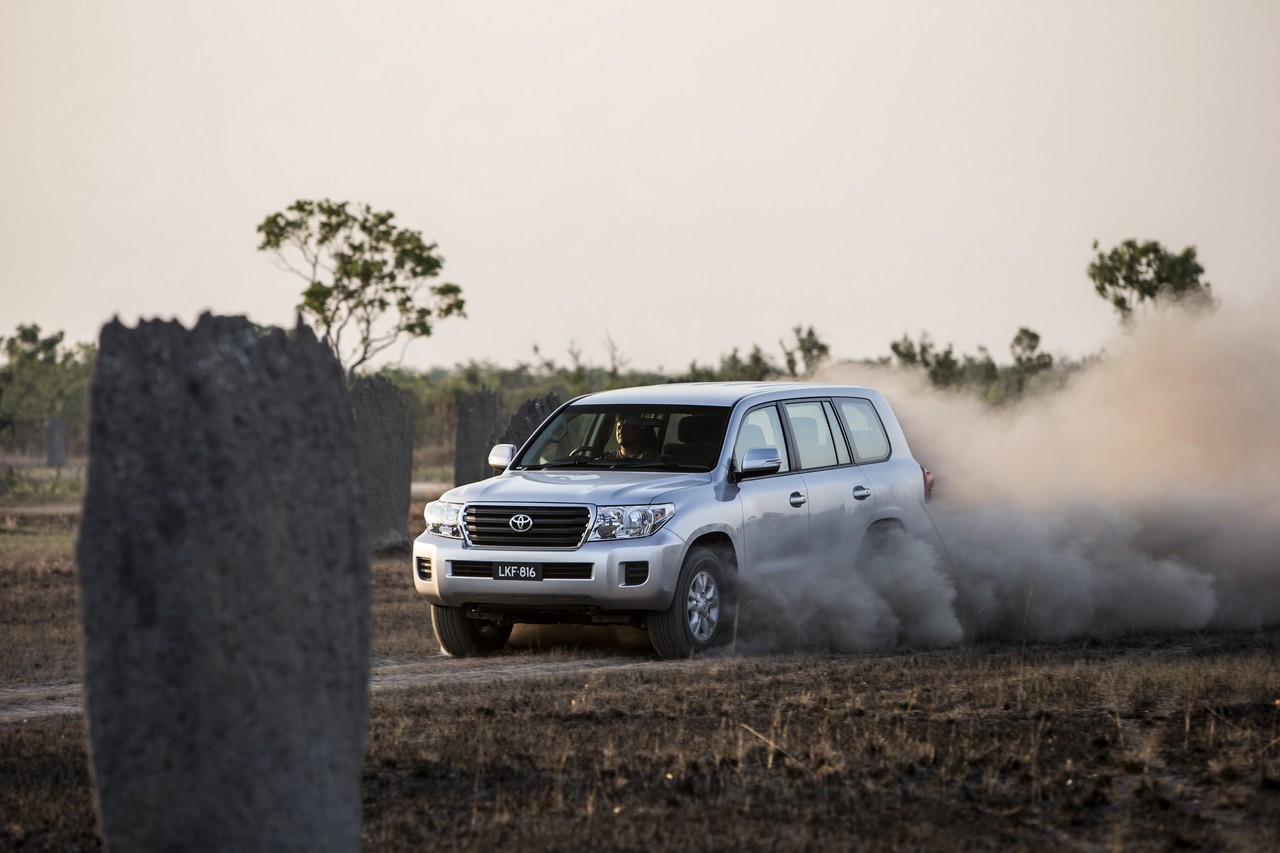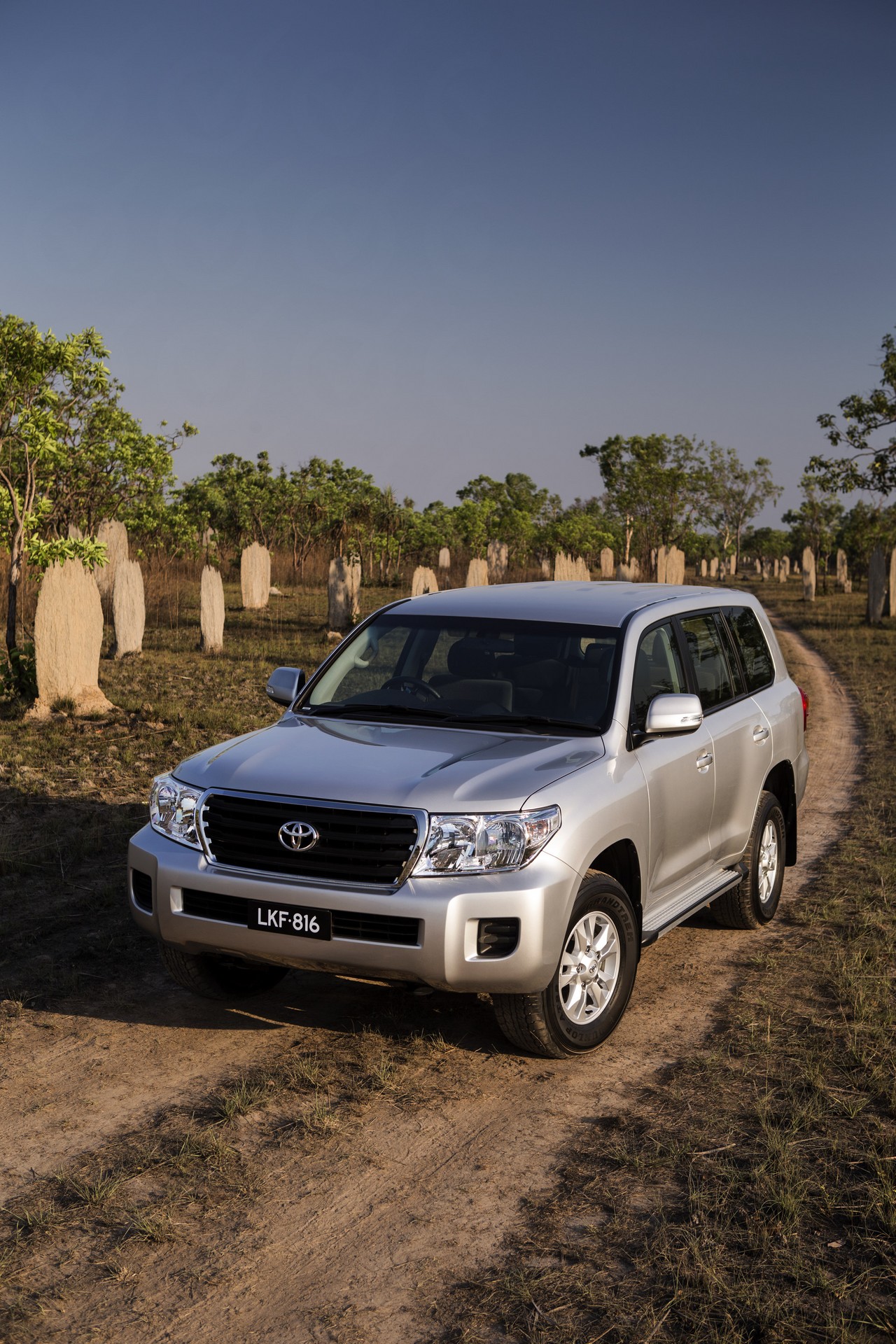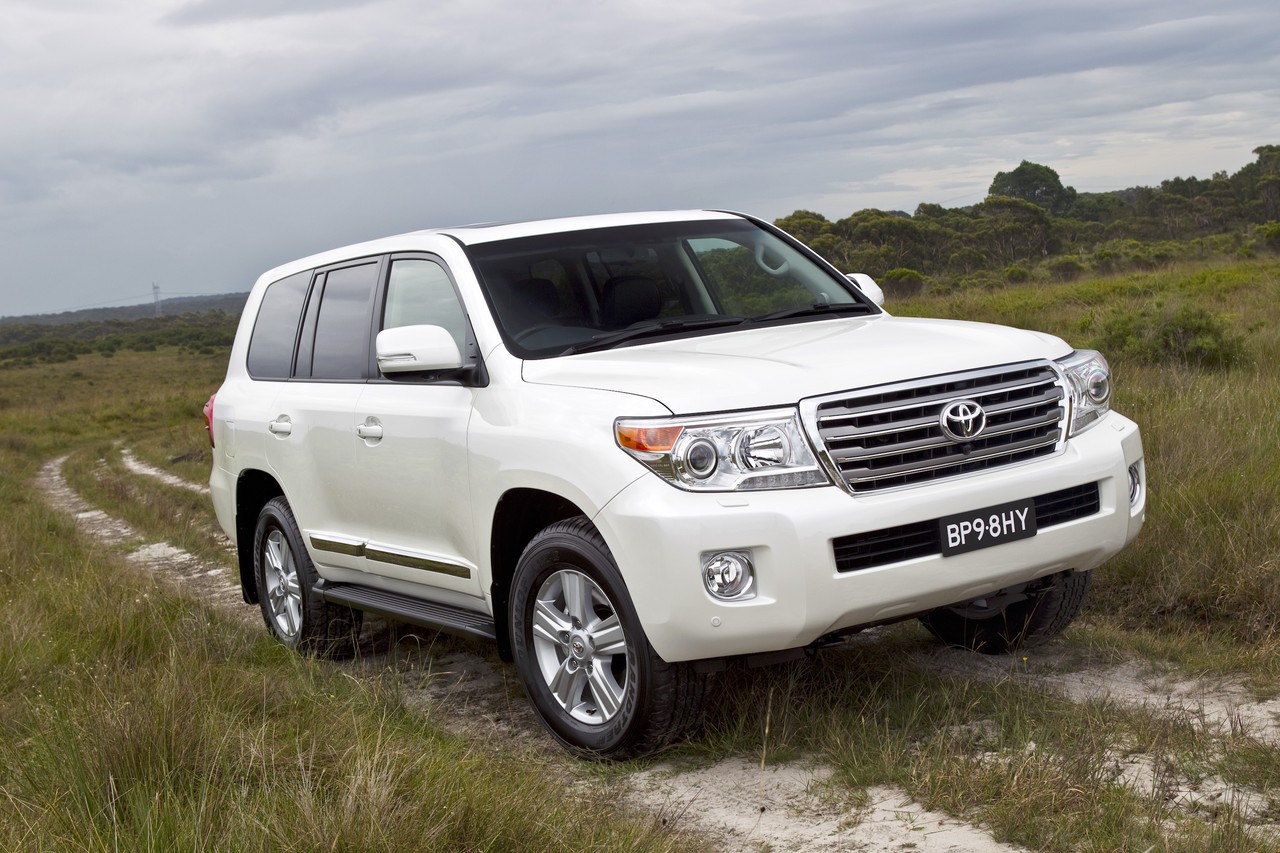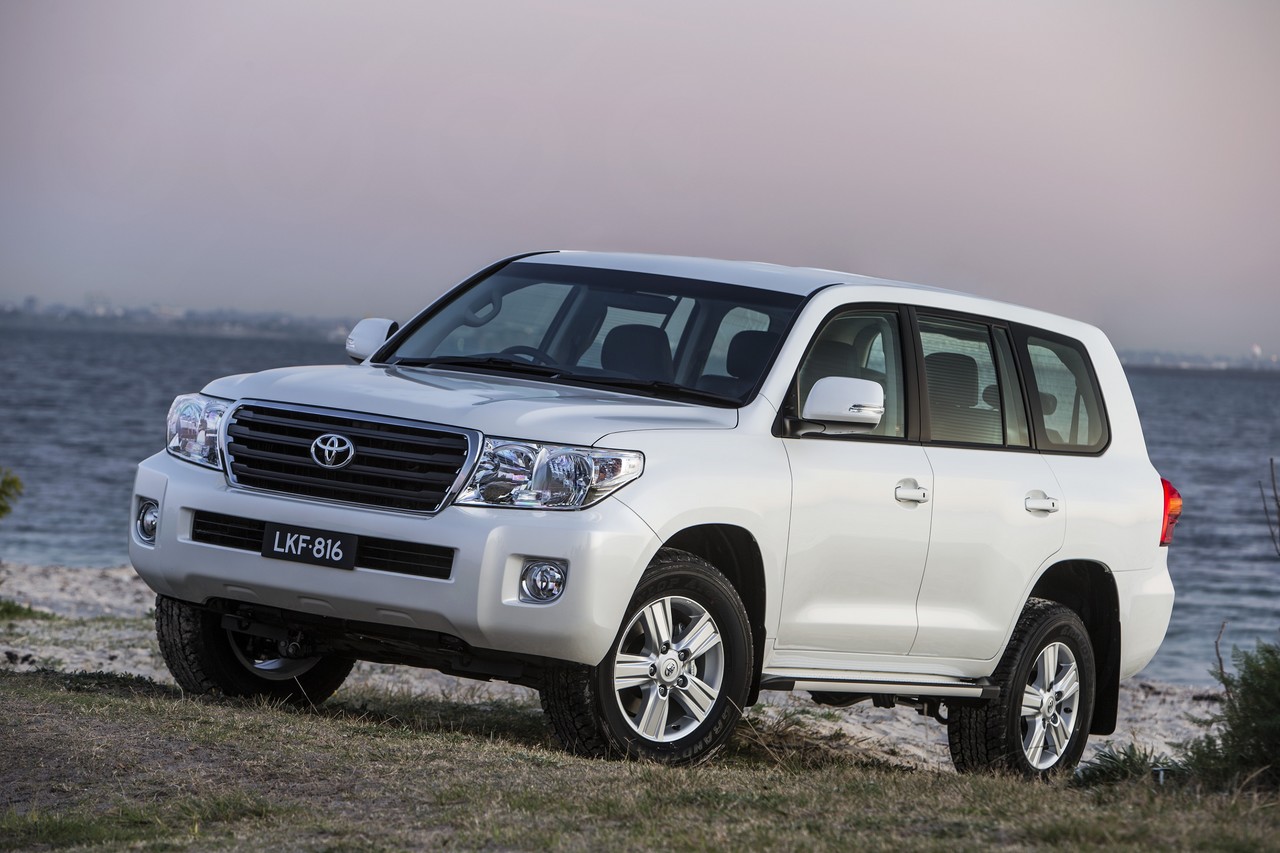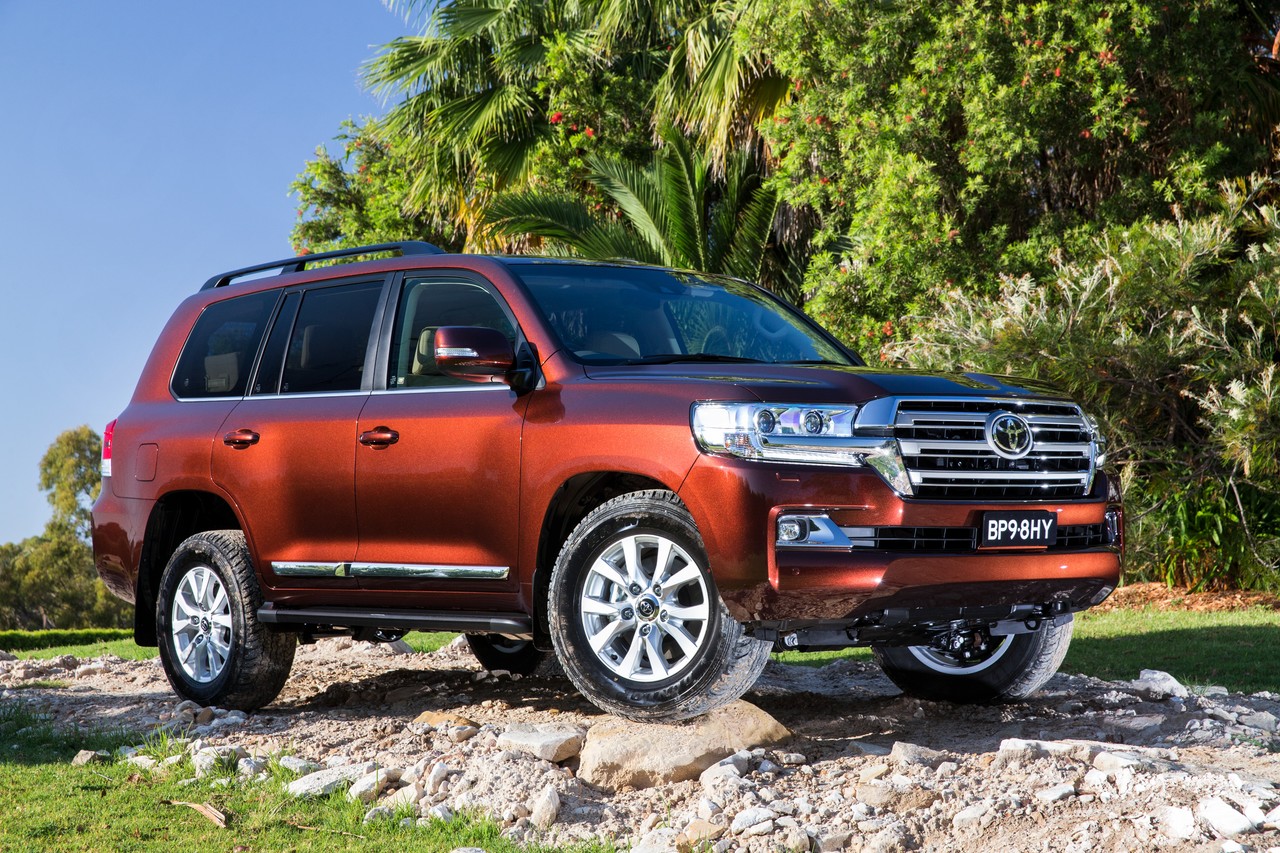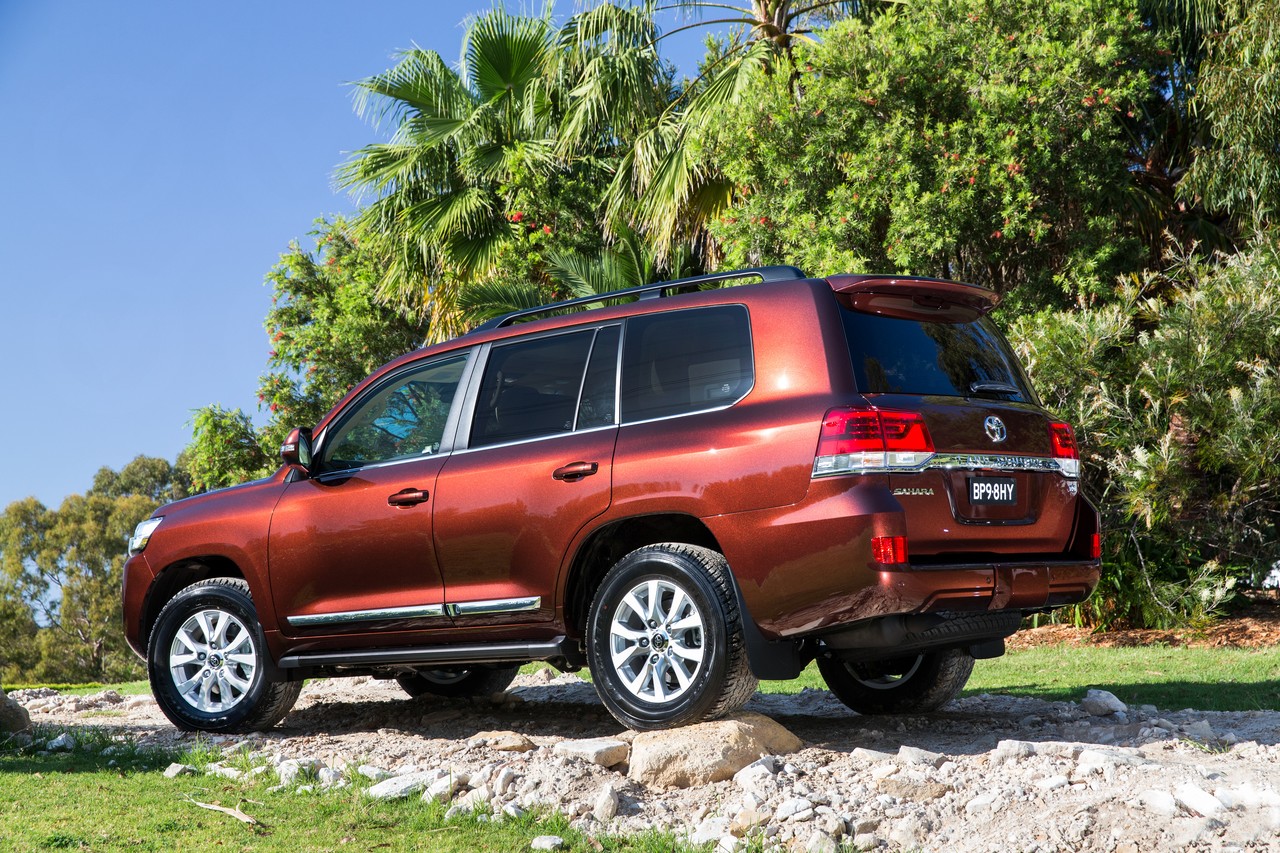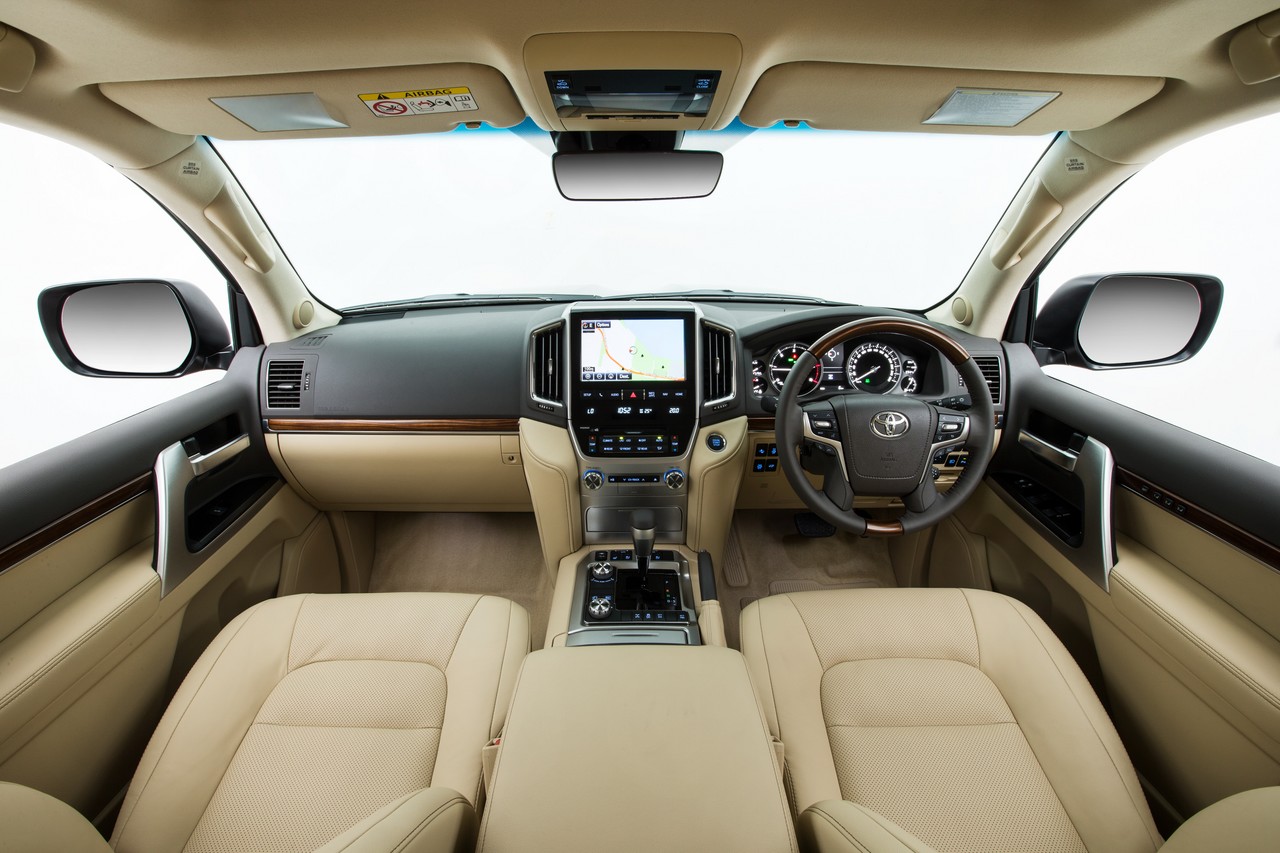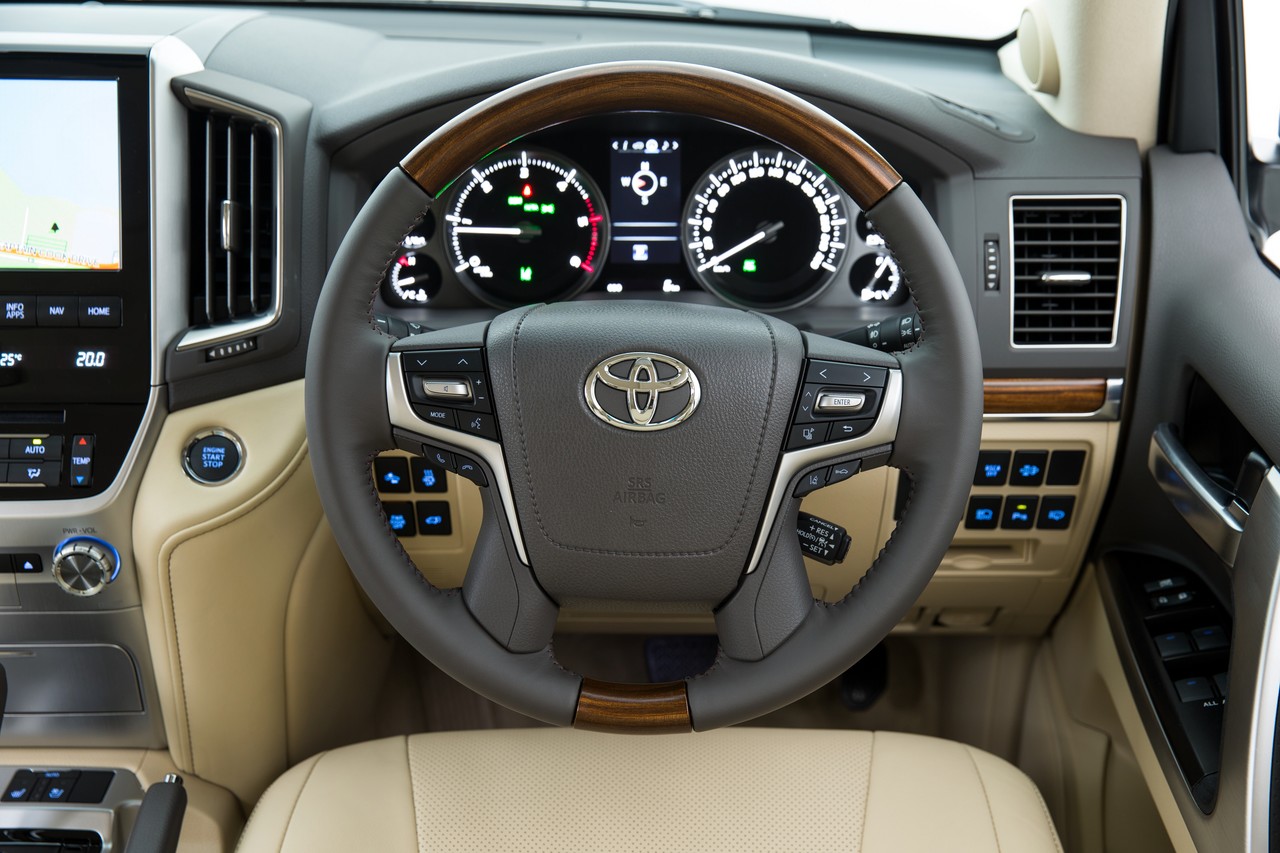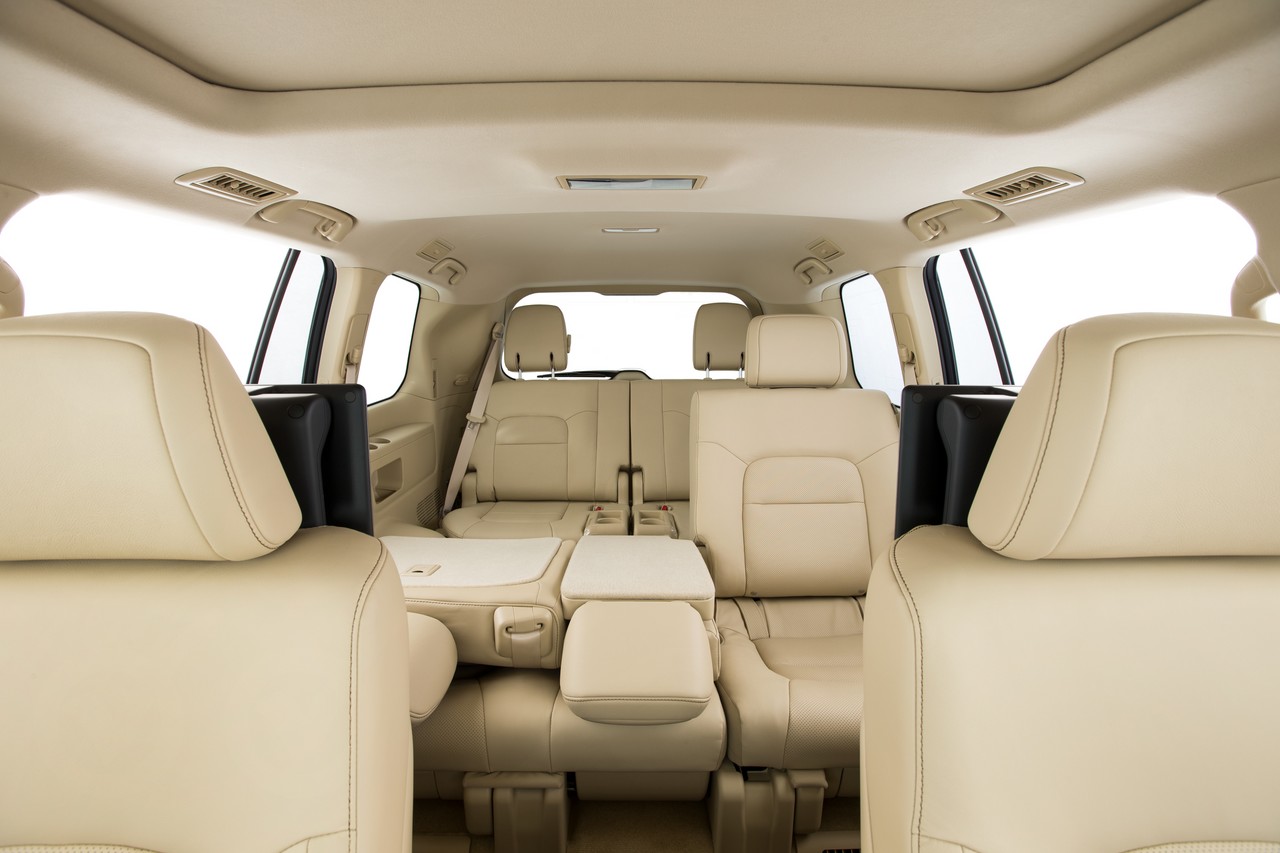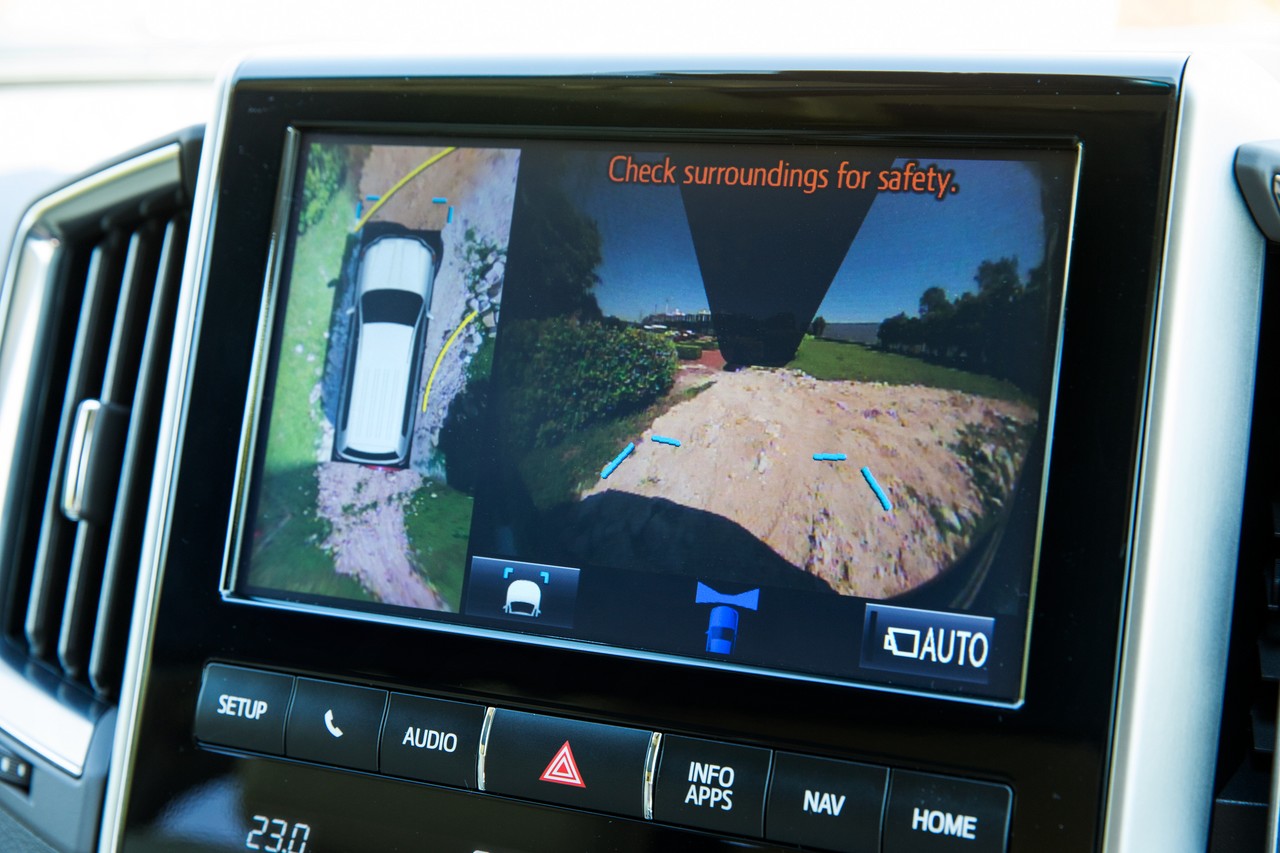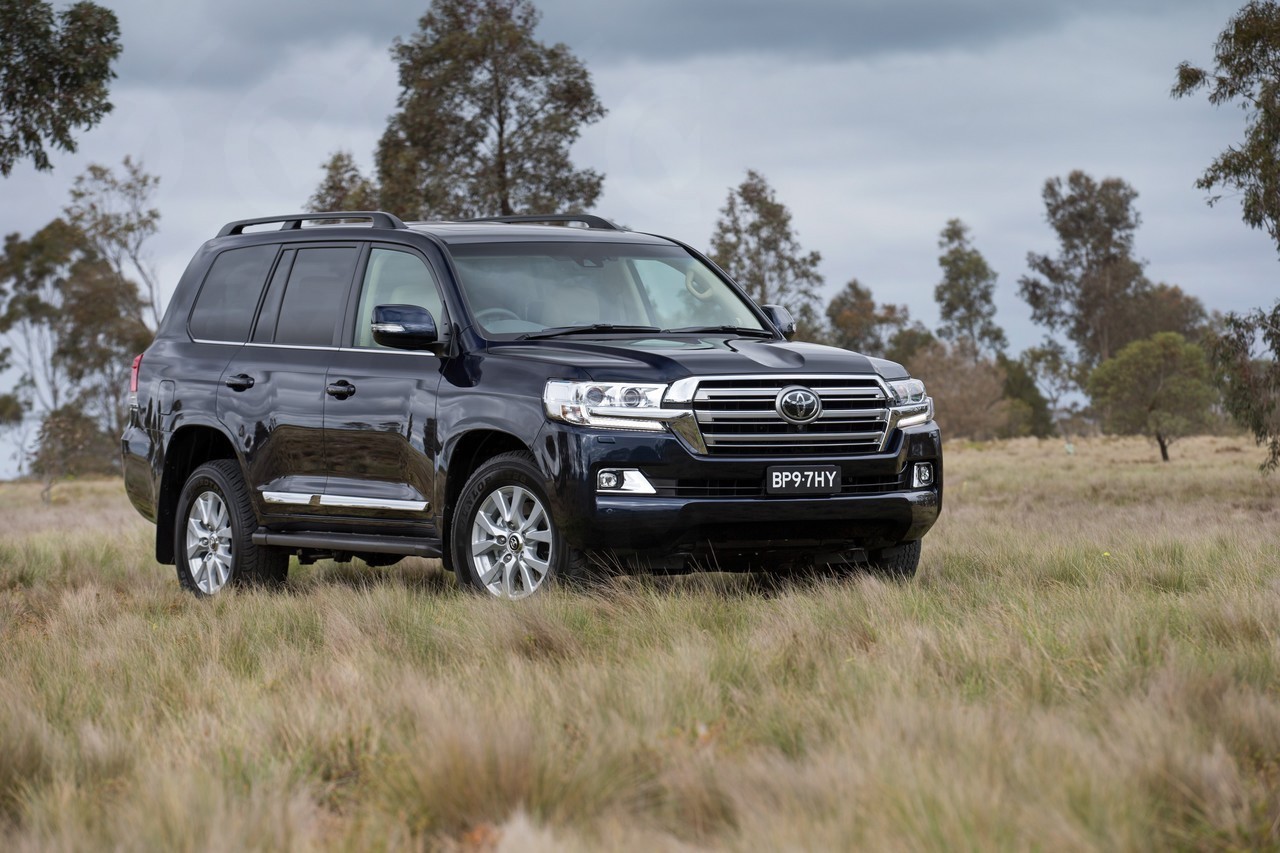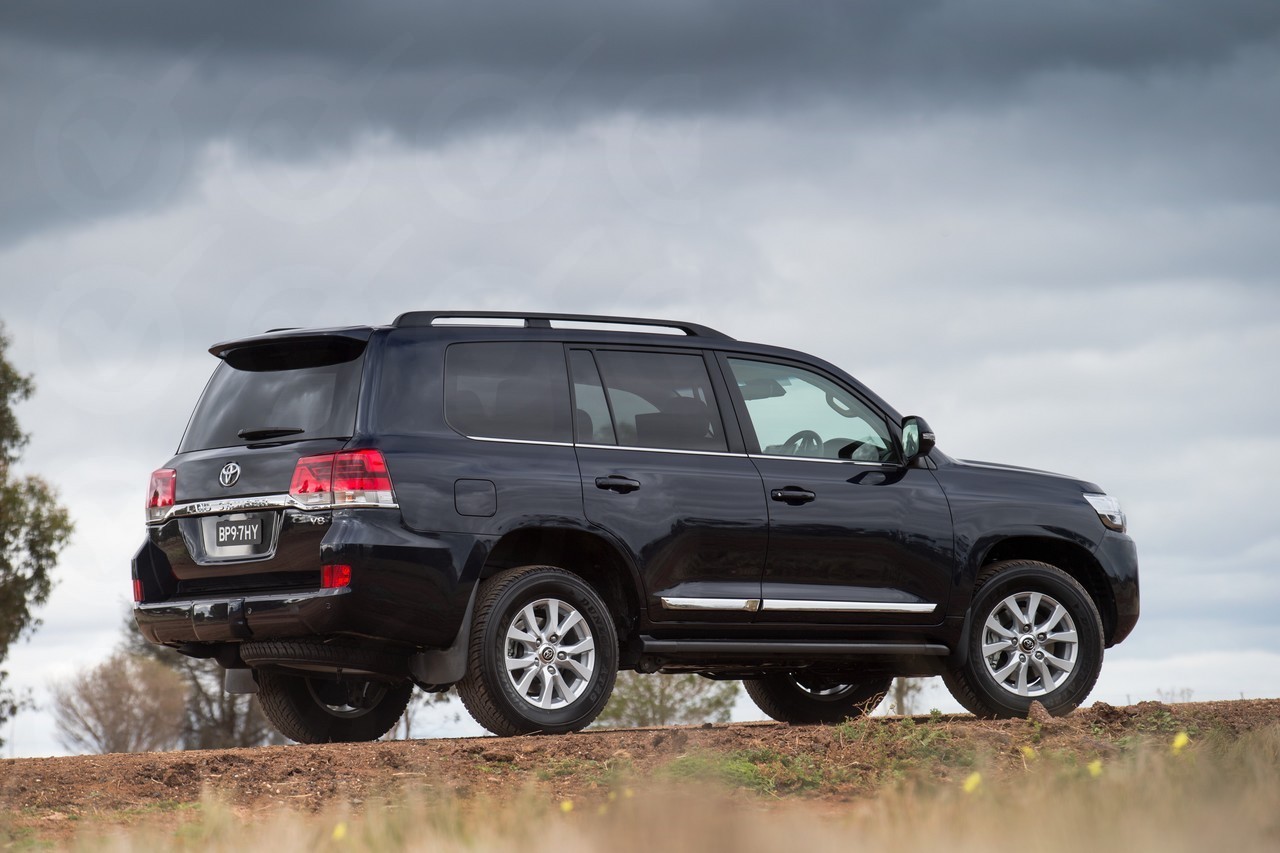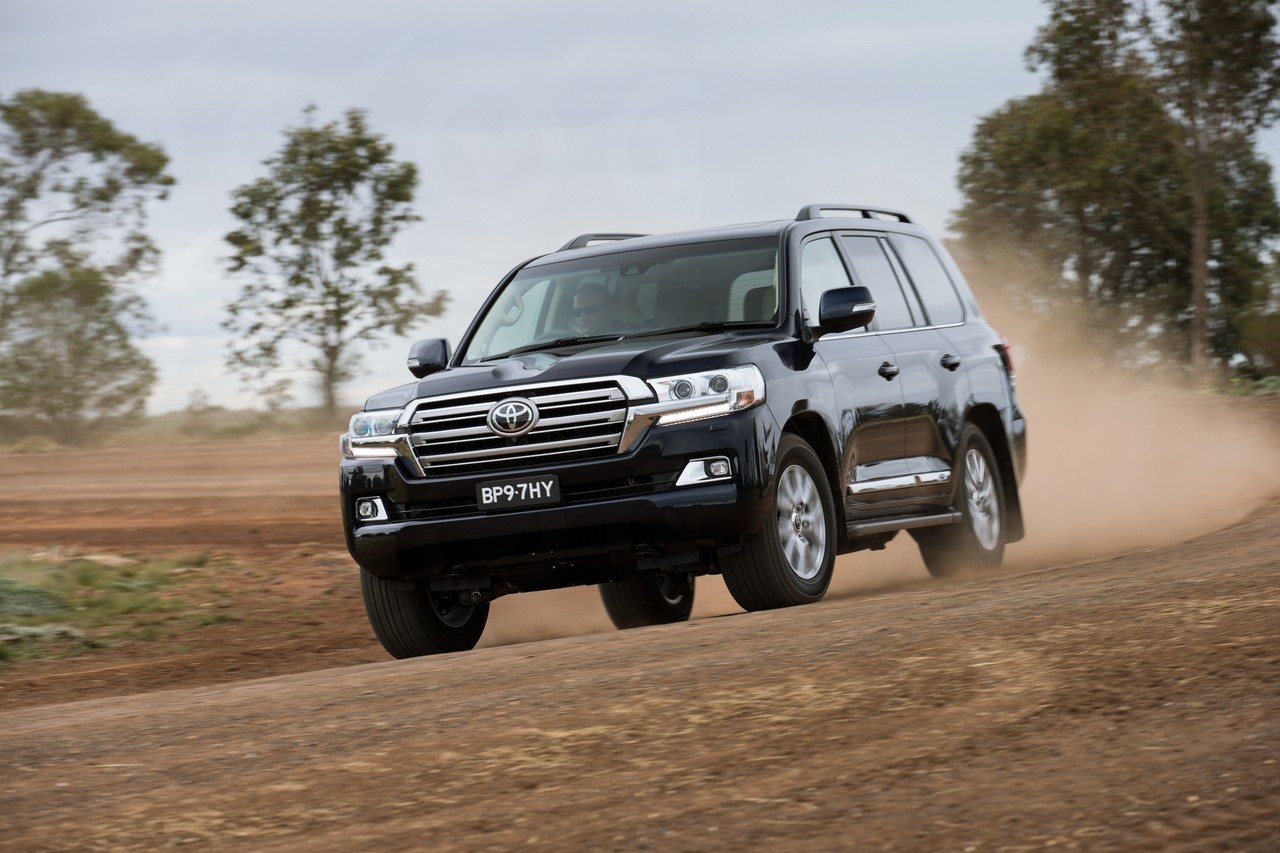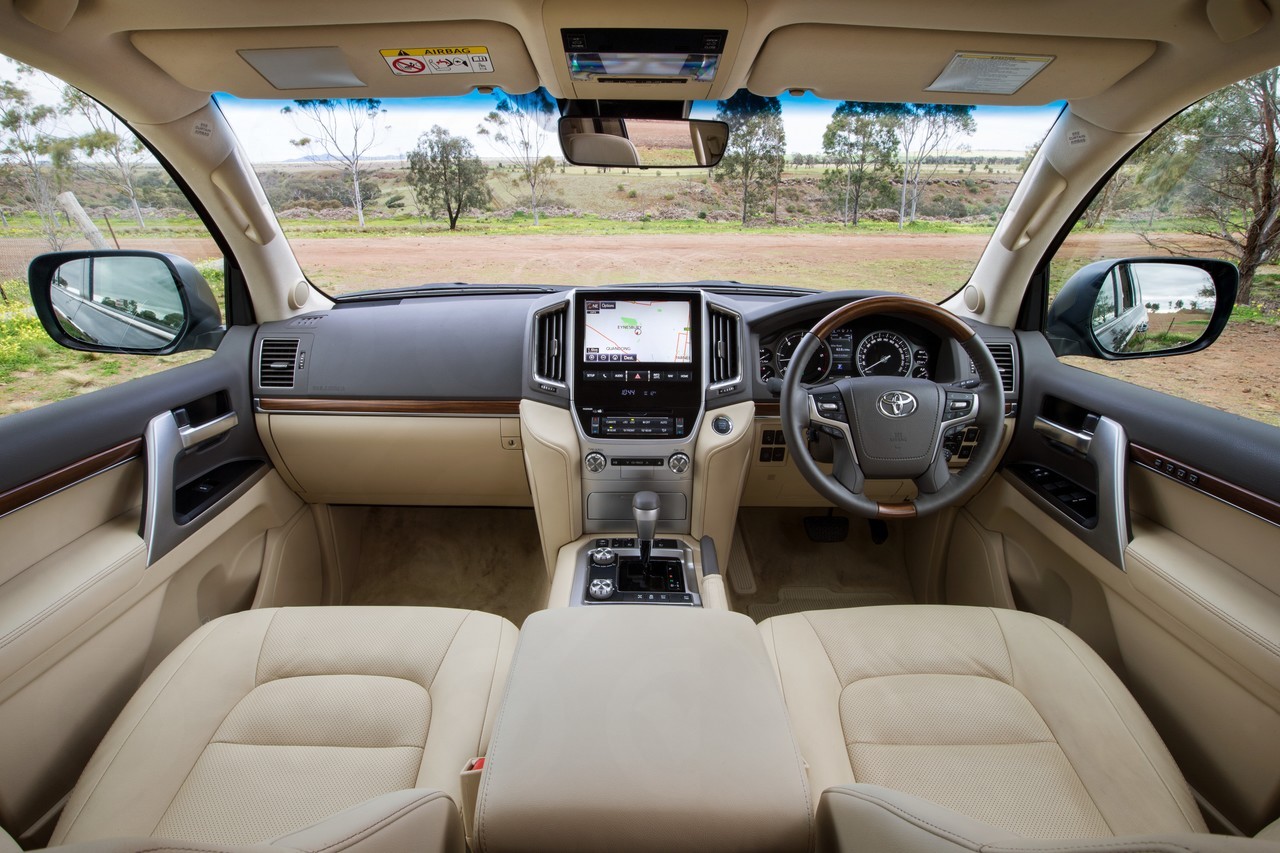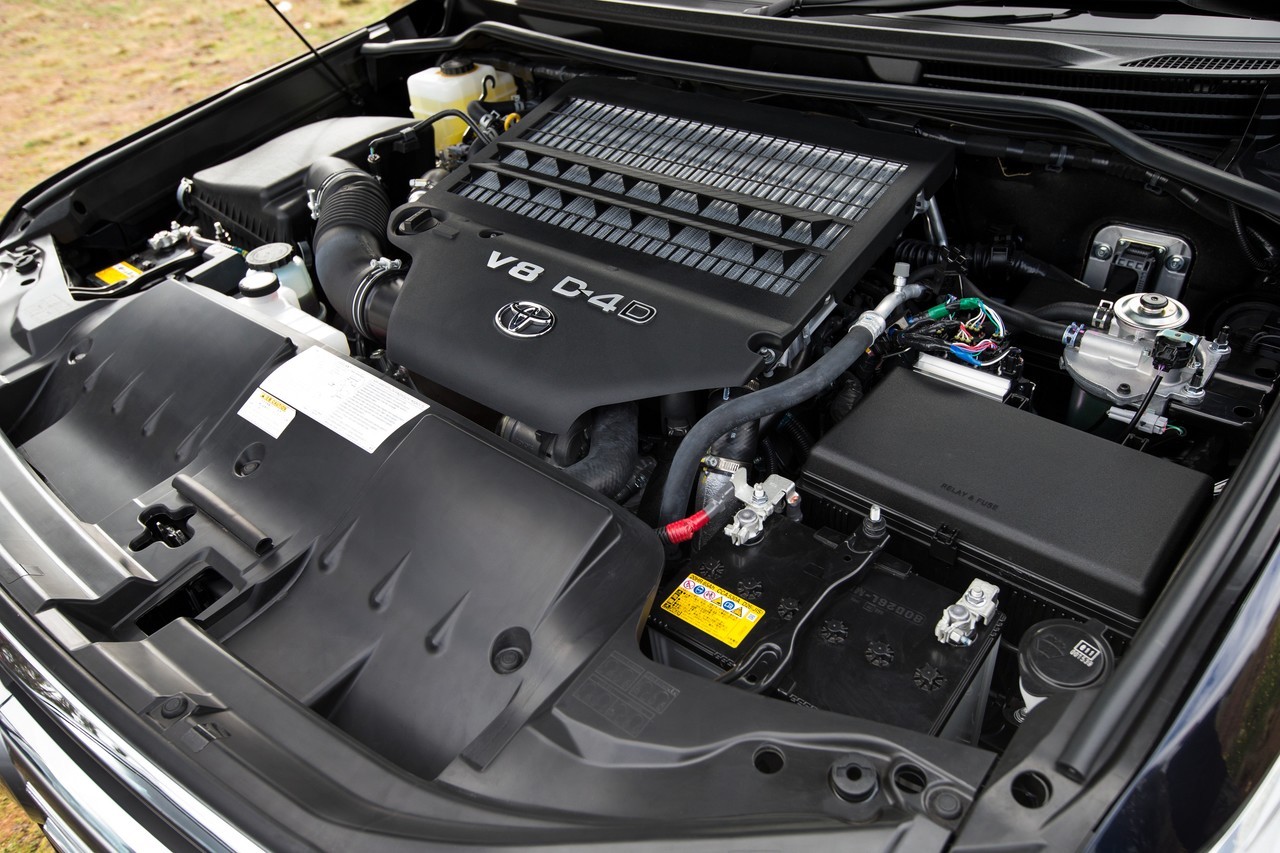
- Refined 4.7-litre 2UZ-FE and 4.6-litre 1UR-FE V8 petrol engines
- Responsive 4.5-litre twin-turbo 1VD-FTV diesel engine
- Quiet, well-insulated cabin
- Suspension provides comfortable ride and good body control
- Off-road ability
- High fuel consumption for petrol engines
- Turbo-diesel engine noise around 2000 rpm
- Flat second row seats
- Brakes can get waterlogged
- Challenging entry and exit for passengers
Review: Toyota 200-I LandCruiser (2007-12)
Overview
Released in November 2007, the Toyota 200-Series Mark I (200-I) LandCruiser was initially available as an eight-seat, four-wheel drive wagon. Manufactured in Japan, the 200-I LandCruiser was powered by 4.7-litre petrol V8 or 4.5-litre twin-turbo diesel engines that were mated to five- and six-speed automatic transmissions, respectively. The 200-I LandCruiser range initially consisted of GXL, VX and Sahara variants. The VX and Sahara variants were also available with seven seats from September 2009, while a new entry-level variant, the GX, was released in November 2011.
2UZ-FE and 1VD-FTV engines
Of the engines,
- The 4.7-litre 2UZ-FE V8 petrol engine had a cast iron cylinder block, double overhead camshafts per cylinder bank (belt-driven), four valves per cylinder, variable intake valve timing (Toyota’s VVT-i), variable length inlet runners (Toyota’s ‘Acoustic Control Induction System’ or ACIS) and a compression ratio of 10.0:1;
- The 4.5-litre 1VD-FTV diesel engine had a nodular graphite iron cylinder block, aluminium alloy cylinder heads, high-pressure direct injection, two RHV4 turbochargers with variable nozzle vanes, an air-to-air intercooler, a forged steel crankshaft, high-strength steel connecting rods, aluminium alloy pistons double overhead camshafts per cylinder bank (chain-driven), four valves per cylinder, a compression ratio of 16.8:1 and exhaust gas recirculation. Australian-delivered LandCruiser diesel engines were also fitted with an ‘air pre-cleaner’.
| Engine | Trans. | Variant | Seats | Peak power | Peak torque |
|---|---|---|---|---|---|
| 4.7-litre petrol V8 (2UZ-FE) | 5sp auto | GXL, VX, Sahara |
8 | 202 kW at 5400 rpm | 410 Nm at 3400 rpm |
| 4.5-litre twin-turbo diesel (1VD-FTV) |
6sp auto | GX | 5 | 195 kW at 3400 rpm | 650 Nm at 1600-2600 rpm |
| GXL | 8 | ||||
| VX, Sahara |
7 or 8 |
Transmissions
The 4.7-litre 2UZ-FE V8 petrol engine was mated to Toyota’s five-speed A750F automatic transmission. The 4.5-litre 1VD-FTV twin-turbo-diesel engine, however, was mated to Toyota’s six-speed AB60F automatic transmission, which featured triple planetary gears and torque-converter lock-up on fifth and sixth gears for improved fuel economy.
Dimensions and body
Compared to the 100-Series LandCruiser , the Toyota 200-Series LandCruiser was 60 mm longer (at 4950 mm), 30 mm wider (1970 mm) and 15 mm taller (1905 mm), though the wheelbase was the same length at 2850 mm. Furthermore, the 200-Series LandCruiser chassis used larger box sections and thicker gauge steel, including high-tensile steel, contributing to a 40 per cent increase in torsional rigidity and a 20 per cent increase in bending rigidity.
Suspension
The Toyota 200-Series LandCruiser had double wishbone front suspension with coil springs (replacing the 100-Series’ torsion-bar arrangement) and a live rear axle with trailing arms and four-link rigid coil suspension. The petrol GLX, VX and Sahara variants (i.e. all variants except the turbo-diesel GX and turbo-diesel GXL) were fitted with a Kinetic Dynamic Suspension System (KDSS) which provided greater wheel articulation by adjusting the resistance of the front and rear stabiliser bars.
4WD system
The Toyota LandCruiser’s full-time four-wheel drive system utilised a torque-sensing Torsen mechanical limited-slip centre differential with a dial-actuated locking function and a two-speed transfer case. In normal conditions, the front/rear torque split was 41:59, but up to 70 per cent of the engine’s torque could be redirected to the rear axle, and 53 per cent to the front. The LandCruiser had a 30-degree approach angle, 25-degree ramp-over angle and 20-degree departure angle.
Models with turbo-diesel models engines fitted with downhill assist control, but petrol variants were fitted with Crawl Control (an off-road cruise system for speeds up to 10 km/h); hill start Assist Control was standard across the range.
Safety equipment
Standard safety equipment for the Toyota LandCruiser GX and GXL included dual front airbags, front side airbags, full-length curtain airbags (i.e. for all three rows of seats), ABS, electronic brake force distribution, brake assist, electronic stability control, traction control and front seatbelt load limiters and seatbelt pretensioners for the front and outer second row seats.
The LandCruiser VX and Sahara were further equipped with twin front knee airbags and second row side airbags.
Brakes
The Toyota 200-Series LandCruiser had 340 mm by 32 mm ventilated front brake discs with four-piston calipers and 345 mm by 18 mm rear discs with single-piston calipers.
ANCAP crash testing
In ANCAP crash testing , the Toyota LandCruiser GX and GXL variants received a four star adult occupant protection rating with a score of 31.09 out of 37. Models with twin front knee airbags (i.e. the VX and Sahara variants for the 200-I LandCruiser range), however, received a five star adult occupant protection rating with a score of 33.09 out of 37.
Features: LandCruiser GX, GXL, VX and Sahara
Standard features for the Toyota LandCruiser GX included 17-inch steel wheels with 285/65 R17 116H tyres, a four speaker sound system with CD player, auxiliary input, MP3-compatibility and Bluetooth capability, air conditioning, 60/40 split fold second row seats, remote central locking and proximity key, power mirrors and windows, tilt and telescopic steering wheel adjustment, tinted windows, side steps, 12 volt power outlets and immobiliser. Unique GX features included an air snorkel, twin rear barn doors, a washable plastic/rubber floor and under-body protection.
Beyond this, the LandCruiser GXL added 17-inch alloy wheels, a six speaker sound system with a six-stack CD player, dual-zone front climate control air conditioning, 50/50 split-fold third row seats and a separately opening tailgate window.
The LandCruiser VX was further equipped with leather seats, power adjustable front seats, front fog lights, sunroof, 40/20/40 split and folding second row seat, a leather-wrapped steering wheel and gearshift, Optitron instrumentation, headlamp cleaning system, privacy glass, courtesy lamps, rear map lights, woodgrain interior trim, trip computer and alarm system.
The range-topping LandCruiser Sahara featured a nine speaker sound system with a six-stack CD/DVD player, four-zone climate control air conditioning, cool box, satellite navigation system with touch-screen, reversing camera, power adjustable steering wheel, power folding mirrors, electrochromatic rear view mirror, wood and leather gearshift lever and steering wheel with audio controls.
September 2009: LandCruiser update
The LandCruiser was updated in September 2009: a reversing camera, steering wheel audio controls, USB input and iPod compatibility were made standard across the range, while diesel models were also fitted with Crawl Control. The VX and Sahara were fitted with 18-inch five-spoke alloy wheels, while petrol and seven-seat turbo-diesel Sahara variants were also fitted with a rear-seat screen for watching DVDs and wireless headphones.
2010 LandCruiser 60th Anniversary
In September 2010, the limited-run LandCruiser 60th Anniversary was released. Based on the GXL, the 60th Anniversary featured leather interior trim, a four-disc CD changer, satellite navigation system, Bluetooth connectivity, leather-wrapped steering wheel and gearshift, silver roof rails and ’60th Anniversary’ badging. Turbo-diesel models were also fitted with the KDSS suspension system.
2011 LandCruiser Altitude
In August 2011, the limited-run LandCruiser Altitude was released. Based on the GXL, the Altitude was fitted with 18-inch alloy wheels, a satellite navigation system with a colour touch screen, leather seat trim, power adjustable front seats and a leather-wrapped gearshift.
Related links
- Press Kit: Toyota 200-I LandCruiser (November 2007)
- Press Release: Toyota 200-I Landcruiser update (September 2009)
- Press Release: Toyota 200-I LandCruiser 60th Anniversary (September 2010)
- Press Release: Toyota 200-I LandCruiser Altitude (August 2011)
- Press Release: Toyota 200-I LandCruiser GX (November 2011)
Review: Toyota 200-II LandCruiser (2012-15)
Overview
Released in March 2012, the 200-Series Mark II (200-II) LandCruiser introduced a new 4.6-litre 1UR-FE V8 petrol engine and a subtle facelift. Combined with a six-speed automatic transmission, the V8 petrol engine also had variable valve timing (for both inlet and exhaust ports) and an ‘acoustic control’ induction system, making it more powerful and fuel-efficient than its predecessor.
Visually, the 200-II LandCruiser could be identified by its new front mask with revised bumpers and grille. Beyond this,
- the GX had a black grille and rear combination lamps with large dual LED lamps;
- the GXL had a black grille with chrome surround, new halogen headlights, indicators integrated within the door mirrors and a roof spoiler;
- the VX received high-intensity discharge headlights with washers, daytime LED running lights and chrome surrounds for the fog lights and parking sensors; and,
- the Sahara was distinguished by chrome highlights within its body-side mouldings.
Inside, there were improved audio systems, while
- the GX was fitted with an economy meter in the instrument cluster to promote fuel-efficient driving;
- the VX gained chrome highlights and a revised multi-information display with colour graphics; and,
- the Sahara’s multi-information display provided information such as steering-wheel angle, a digital speed reading and turn-by-turn instructions for the navigation system.
1UR-FE V8 engine
The 4.6-litre 1UR-FE V8 petrol engine had a die-cast aluminium block, aluminium cylinder head, magnesium cylinder covers, double overhead camshafts per cylinder bank (belt-driven), variable intake and exhaust valve timing (Toyota’s ‘Dual VVT-i’) and a compression ratio of 11.8:1.
The 4.6-litre 1UR-FE V8 petrol engine was mated to Toyota’s six-speed AB60F automatic transmission (the same transmission used for the 4.5-litre 1VD-FTV twin-turbo diesel engine).
| Engine | Trans. | Variant | Seats | Peak power | Peak torque |
|---|---|---|---|---|---|
| 4.6-litre petrol V8 (1UR-FE) | 6sp auto | GXL, VX, Sahara |
8 | 228 kW at 5500 rpm | 439 Nm at 3500 rpm |
| 4.5-litre twin-turbo diesel V8 (1VD-FTV) |
6sp auto | GX | 5 | 195 kW at 3400 rpm | 650 Nm at 1600-2600 rpm |
| GXL | 8 | ||||
| VX, Sahara |
7 |
4WD system
The Crawl Control system was improved to include five settings and an Off-road Turn Assist function which could automatically apply the inside rear brake to reduce the vehicle’s turning circle. Furthermore, the VX and Sahara variants were fitted with a ‘Multi-Terrain Select’ system which regulated wheel-spin in off-road conditions with five selectable modes: rock, rock and dirt, mogul, loose rock, mud and sand.
Safety equipment
Compared to its 200-I predecessor, standard safety equipment for the 200-II LandCruiser was unchanged. The ABS system, however, was extended to include a multi-terrain capability which could detect and adapt to off-road conditions.
From March 2013, dual front knee airbags and trailer sway control were fitted as standard. As a result of the introduction dual front knee airbags, all post-March 2013 LandCruisers were awarded a five star adult occupant protection rating from ANCAP.
Features
Standard features for the LandCruiser GX were unchanged. Features for the LandCruiser GXL, however, were extended to include a satellite navigation system with 6.1-inch touch-screen display, single disc CD player, alarm system and 220 volt connector in the rear.
The LandCruiser VX gained rain-sensing wipers, power retractable mirrors and a moonroof.
The LandCruiser Sahara was further equipped with air conditioned front seats, heated second row seats, an upgraded navigation system, a power-operated tailgate and three memory positions for the driver’s seat, steering wheel and door mirrors.
The Sahara was also fitted with a ‘Multi-Terrain Monitor’ which utilised four wide-angle cameras for checking blind spots and revealing terrain hazards and apexes that are normally hidden from the driver’s view.
March 2013: LandCruiser update
From March 2013, standard LandCruiser features were extended to include rear privacy glass, the VX and Sahara gained automatic (i.e. dusk-sensing) headlights, while the Sahara was also fitted with a digital (DAB) radio receiver.
LandCruiser Altitude
II August 2012, June 2013 and July 2014, limited-run LandCruiser Altitude models were released. Fitted with 4.5-litre twin-turbo V8 diesel engines, the Altitude variants were based on the GXL but further equipped with 18-inch alloy wheels, power adjustable front seats, black leather seat trim, a cooler box and an upgraded steering wheel and gearshift knob.
Brochures
- Brochure: Toyota 200-II LandCruiser (November 2013)
- Brochure: Toyota 200-II LandCruiser (September 2015)
Related links
- Press Release: Toyota 200-II LandCruiser (March 2012)
- Press Release: Toyota 200-II LandCruiser Altitude (August 2012)
- Press Release: Toyota 200-II LandCruiser update (March 2013)
- Press Release: Toyota 200-II LandCruiser Altitude (June 2013)
- Press Release: Toyota 200-II LandCruiser Altitude (July 2014)
Review: Toyota 200-III LandCruiser (2015-21)
Overview
Released in Australia in October 2015, the Toyota 200-Series Mk.III (200-III) LandCruiser introduced revised engines for Euro 5 emissions standards and updated styling. Inside, the 200-III LandCruiser had soft-touch padding for contact surfaces and repositioned switches for the audio, air conditioning and driver-related functions. For all variants, the centre console had a storage compartment with a 12 volt outlet, while the LandCruiser Sahara also featured a wireless charger.
The 200-III LandCruiser could be identified by its hexagonal upper grille with triple horizontal bars, recessed projector-style headlights, wider lower grille, new bonnet, fenders and bumper. At the rear, there was a new upper tailgate panel, combination lamps and reflectors, bumper and mudguards. Copper Brown and Onyx Blue paint finishes were also introduced and available on all variants except the LandCruiser GX.
1UR-FE and 1VD-FTV engines
For the 4.6-litre 1UR-FE V8 petrol engine , the air-injection system was revised to reduce emissions by inducing secondary air through the exhaust ports for faster warm-up of the catalytic converters.
For the 4.5-litre 1VD-FTV twin-turbo diesel V8 engine , changes included:
- New injectors;
- Revised mapping; and,
- A diesel particulate filter with guard for off-road protection.
As part of these changes, peak power increased to 200 kW and fuel consumption for the combined ADR 81/02 test cycle was 9.5 litres per 100 km.
| Engine | Trans. | Variant | Seats | Peak power | Peak torque |
|---|---|---|---|---|---|
| 4.6-litre petrol V8 (1UR-FE) | 6sp auto | GXL, VX, Sahara |
8 | 228 kW at 5500 rpm | 439 Nm at 3500 rpm |
| 4.5-litre twin-turbo diesel V8 (1VD-FTV) |
6sp auto | GX | 5 | 200 kW at 3400 rpm | 650 Nm at 1600-2600 rpm |
| GXL | 8 | ||||
| VX, Sahara |
7 |
Safety equipment
For the LandCruiser Sahara, standard safety equipment was extended to include:
- Toyota’s ‘Pre-Collision Safety System’: could detect the distance and relative speed of the vehicle ahead. If a risk of collision was detected, a warning tone would initially sound to alert the driver. In its secondary stage, the system would increase braking assistance and, if the driver failed to respond, the system would automatically apply the brakes and pre-tension the front seatbelts;
- Dynamic Radar Cruise Control: maintained a safe distance from the vehicle ahead (including merging traffic) by adjusting vehicle speed when cruise control is active;
- Lane Departure Alert: warned the driver if the vehicle was about to drift across lanes without the indicators having been activated;
- Blind-spot monitor: used a sub-millimetre radar used to detect vehicles in adjacent lanes and alert the driver if changing lanes. The system is understood to activate once the vehicle exceeded 40 km/h and can detect a maximum relative speed difference of 28 km/h; and,
- Rear Cross Traffic Alert (RCTA): could warn the driver of approaching vehicles when reversing out of a parking space. Specifically, RCTA operated when the vehicle was reversing at less than 8 km/h and the approaching vehicles were approaching at speeds between 8 km/h and 28 km/h.
From October 2018, the LandCruiser VX was equipped with:
- A blind-spot monitor; and,
- Rear Cross Traffic Alert (RCTA).
Features
Compared to its 200-II predecessor, standard features for the 200-III LandCruiser GX were extended to include a 12-volt accessory socket in the centre console. The LandCruiser GXL, however, gained LED low-beam headlights, LED clearance lamps, a leather-accented steering wheel and gearshift knob, variable intermittent wipers and roof rails.
Relative to its predecessor, the 200-III LandCruiser VX added bi-LED headlights and LED front fog lamps. Furthermore, both the 200-III LandCruiser VX and Sahara received a new Optitron instrument cluster with a 4.2-inch thin-film transistor colour Multi Information Display and an ‘Electro Multi Vision and Navigation’ unit with a larger nine-inch display screen (previously eight-inch).
The Toyota 200-III LandCruiser Sahara gained ventilated front seats and a wireless smartphone charger, while the four-camera ‘Multi-Terrain Monitor’ was upgraded to provide a bird’s eye view of the vehicle and the front camera would tilt so that the horizon was displayed as level on the enlarged in-car display. Furthermore, an under-floor view could display terrain approximately three (3) metres ahead of the LandCruiser Sahara so that the driver could see obstacles ahead of the front wheels.
October 2018 update
From October 2018,
- The LandCruiser GXL was equipped with front and rear parking sensors, and the instrument cluster gained a 4.2-inch multi-information display; and,
- The LandCruiser VX was equipped with the Multi-Terrain monitor and auto-dimming mirrors (interior and exterior).
2017 Toyota LandCruiser Altitude
Based on the LandCruiser GXL and solely available with the 4.5-litre twin turbo diesel engine, the Toyota LandCruiser Altitude was released in April 2017. Compared to the LandCruiser GXL, features for the LandCruiser Altitude were extended to include leather-accented upholstery, power adjustable front seats, a refrigerated cool box, rain-sensing wipers, chrome-tipped front air vents, brushed ‘alloy-look’ ornamentation, LED Optitron meters and a 4.2-inch multi-information display. Visually, the LandCruiser Altitude could be identified by its LED fog lamps and ‘Altitude’ badges.
Production of the Toyota LandCruiser Altitude was limited to six hundred (600) vehicles.
Brochure
Related links
- Press Release: LandCruiser Extends Its Reign (August 2015)
- Press Release: Toyota Launches “All-Seeing” LandCruiser (October 2015)
- Press Release: Toyota LandCruiser Altitude (April 2017)
- Press Release: Toyota Boost Safety and Assistance Technology for LandCruiser 200 Series (October 2018)
- Toyota Australia: Toyota Landcruiser
- Wikipedia.org: Toyota 200 Landcruiser
